The Palmetto & Crescent is done curing!
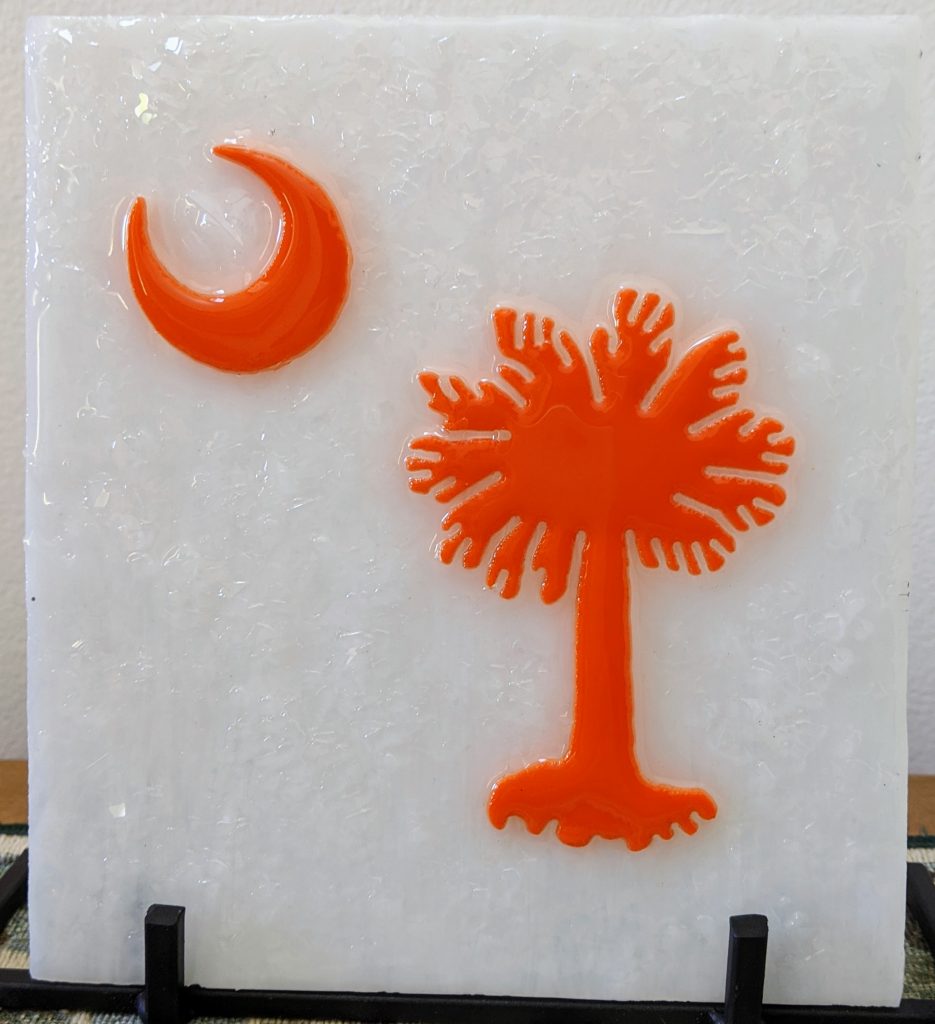
Glass of Sherry
The Palmetto & Crescent is done curing!

So doing the wave layers just takes a short amount of time (maybe an hour total including setup and cleanup) each day, but here is today’s progress. First I mixed 80 ml of resin, setting aside a very small amount (about 1 TBSP) for the white pigment for the wave bubbles. I then spread the resin over most of the glass, leaving out most of the part where the sand and the first white bubbles are located. I then used the heat gun to remove bubbles and added a line of white resin all along the very edge of the clear resin.
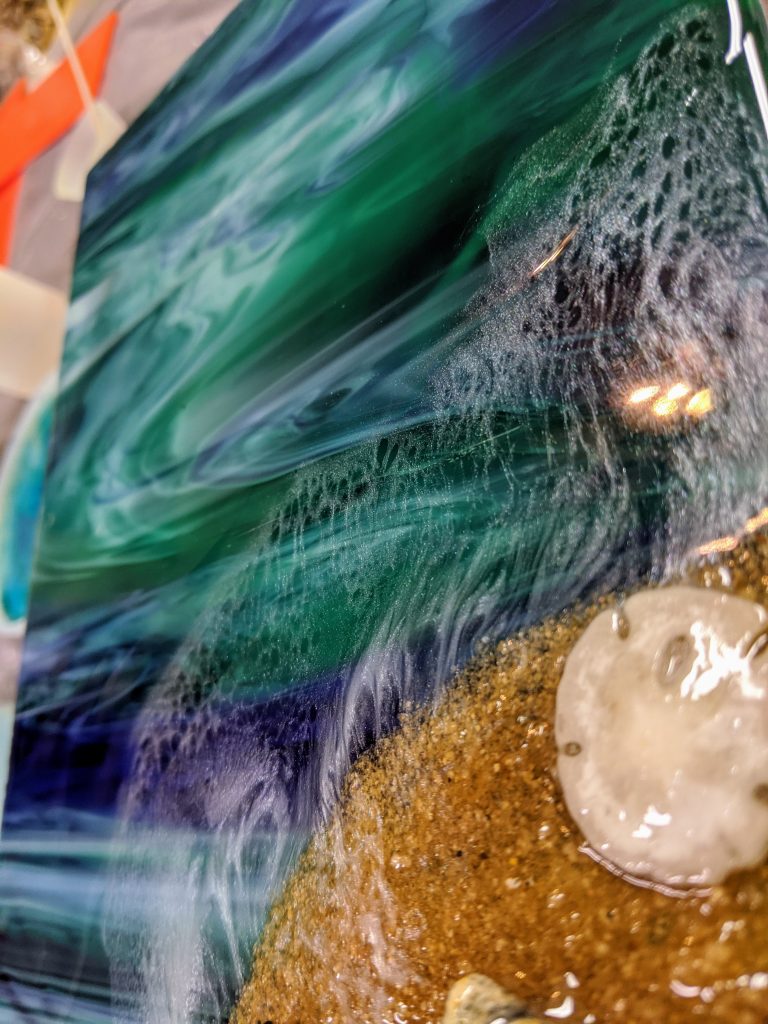
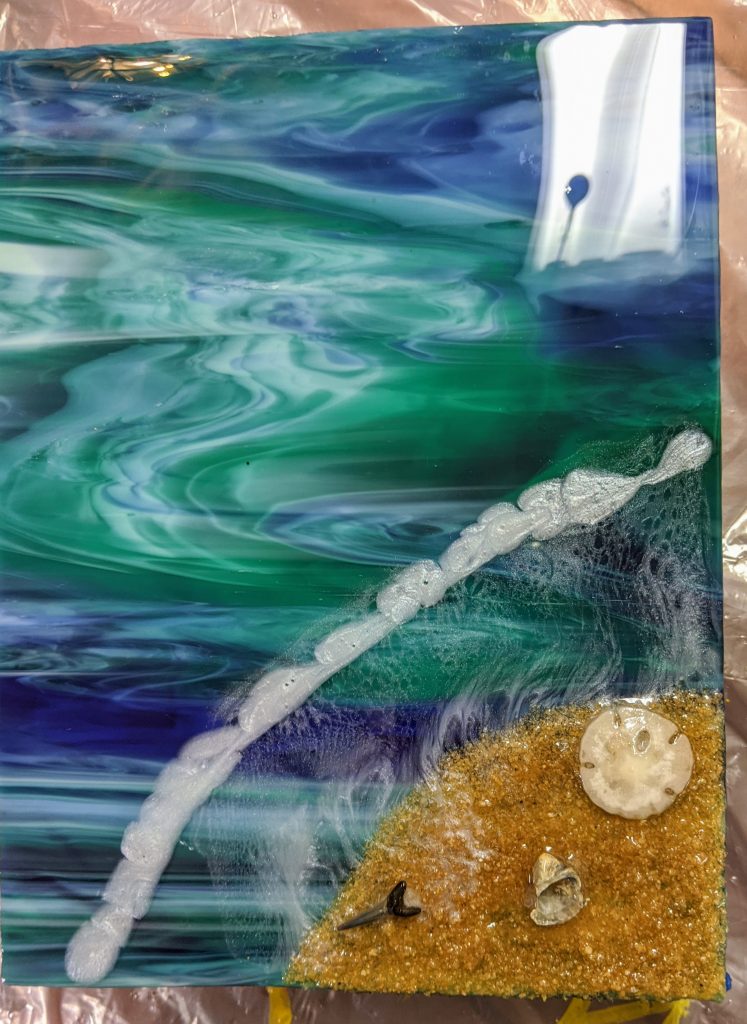
Next I used the heat gun to spread the white pigment and then the torch to add detail to the bubbles.
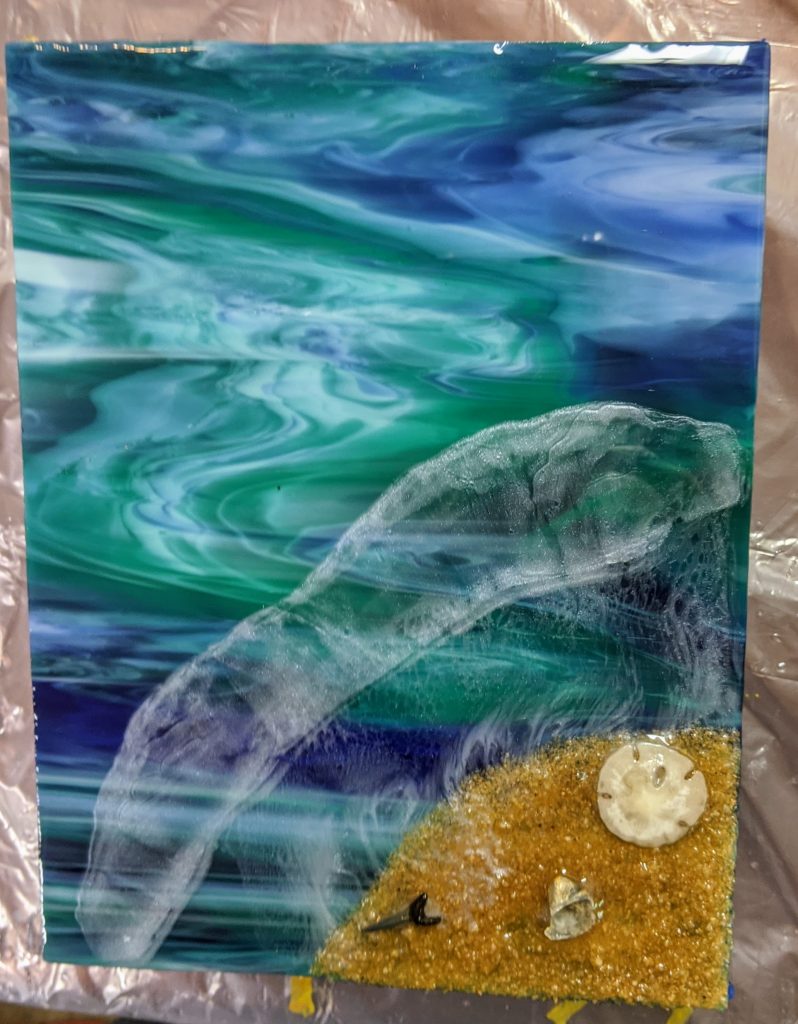
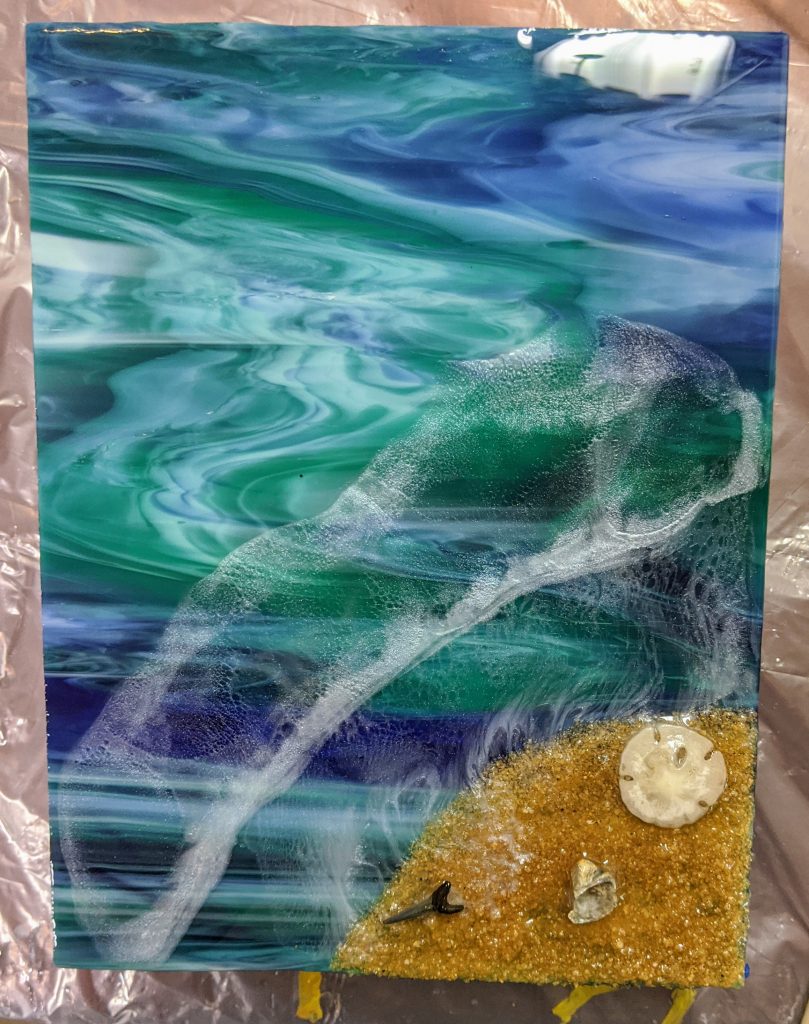
I also had some touch up to do on the Palmetto and Crescent panel, as I added glass chips late last night and sprayed over them with resin spray and I wasn’t happy with the look. Soooo I spread another layer of clear resin over the panel and added the chips again. I also used the leftover clear resin to finish up one of the coasters from yesterday, so tomorrow I should be able to see how it looks. 🙂 I will also add at least one more wave to the beach panel (hopefully also tomorrow).
So yesterday I planned to work on these, but my real job was too busy, so today was the day. I added the first wave layer to my second beach / waves over stained glass panel, poured the resin coating on my stained glass “Clemson” colors Palmetto and Crescent panel, and added the second layer to my two alcohol ink / gold flake resin coasters.
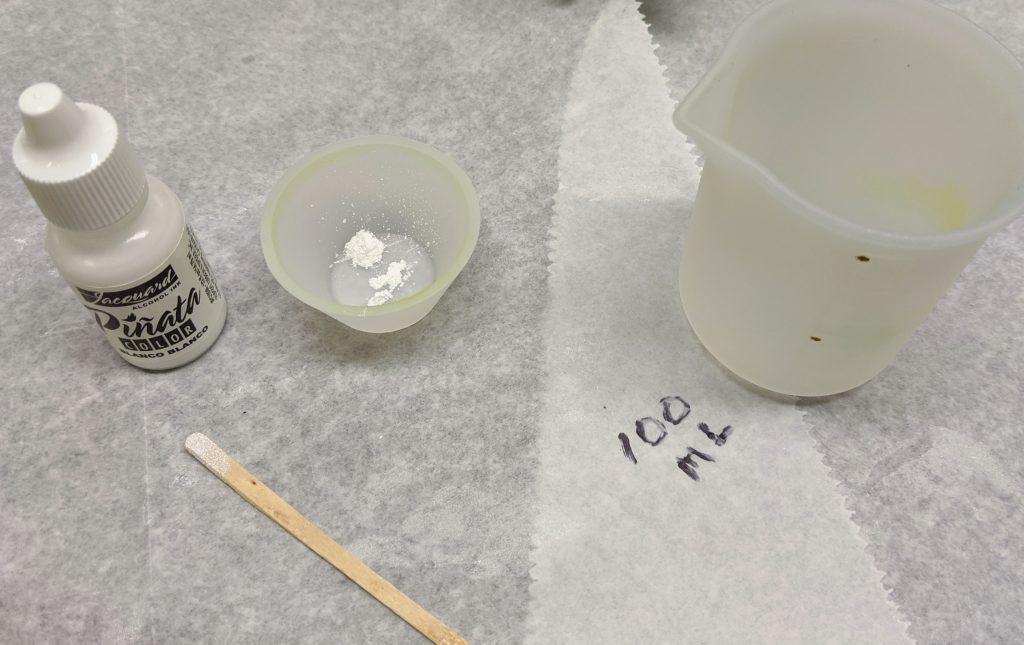
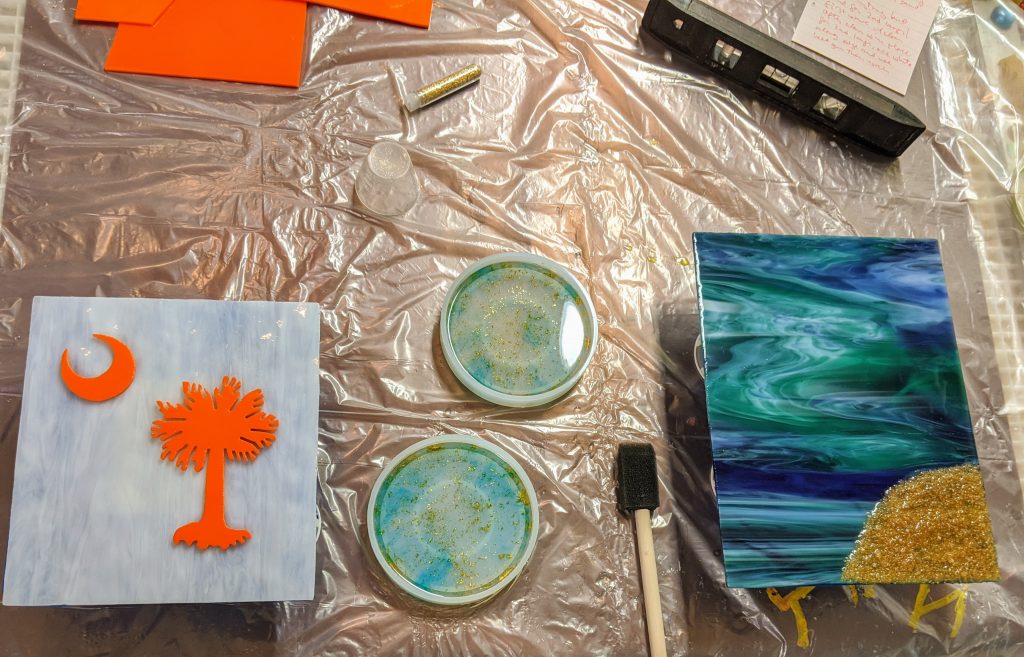
I mixed 100 ml of resin, then set a small amount aside for the white part of the waves on my beach panel. Next I poured the clear layer of resin over the glass panels and spread the resin around with a sponge on a stick.
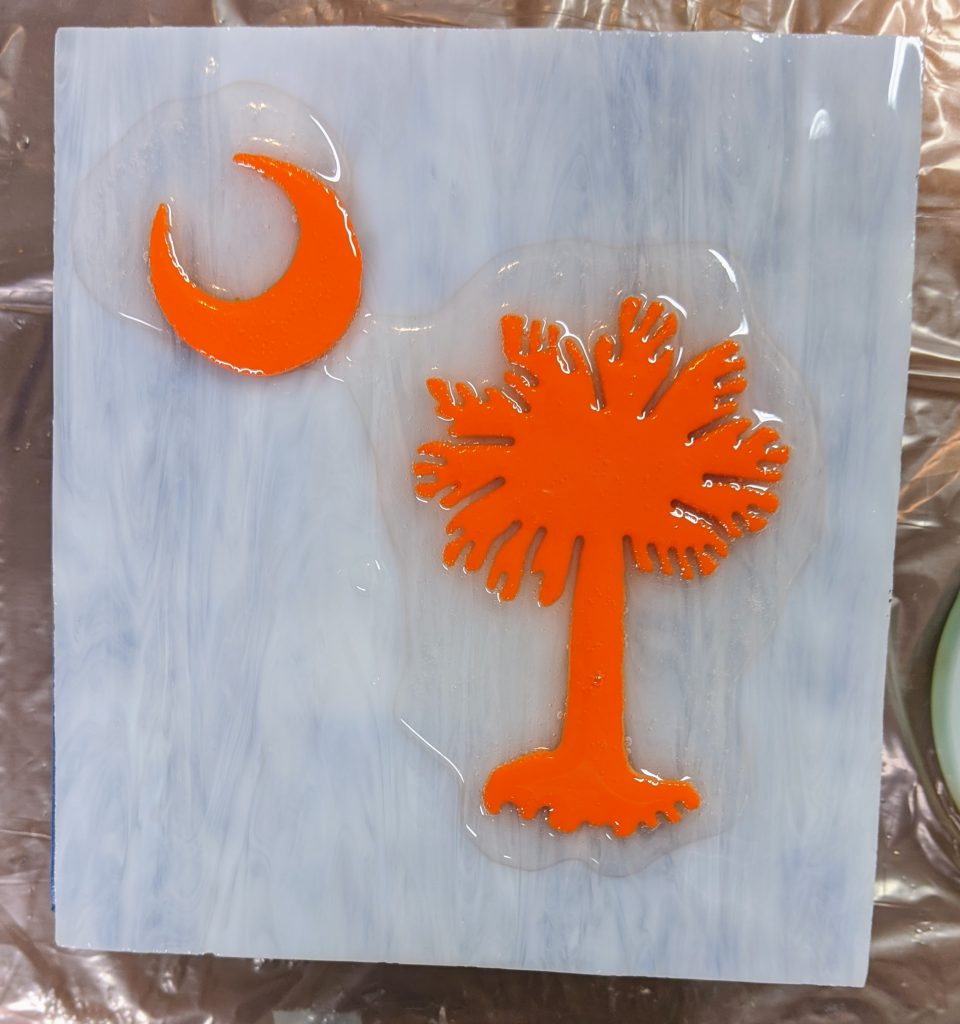
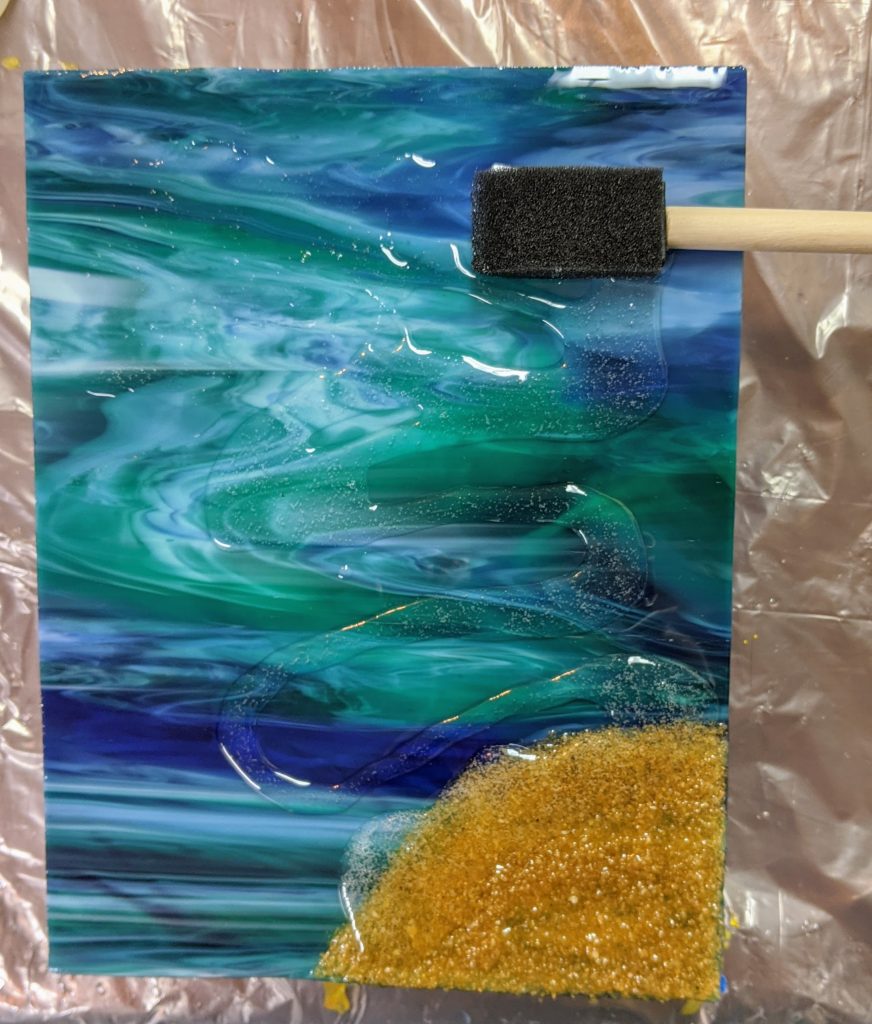
Once the resin was spread all over the base glass, I used my heat gun to remove bubbles and spread the resin a bit more evenly. Next, I added a line of white tinted resin (powdered pigment plus a drop of white alcohol ink) to the sandy beach part of the wave panel.
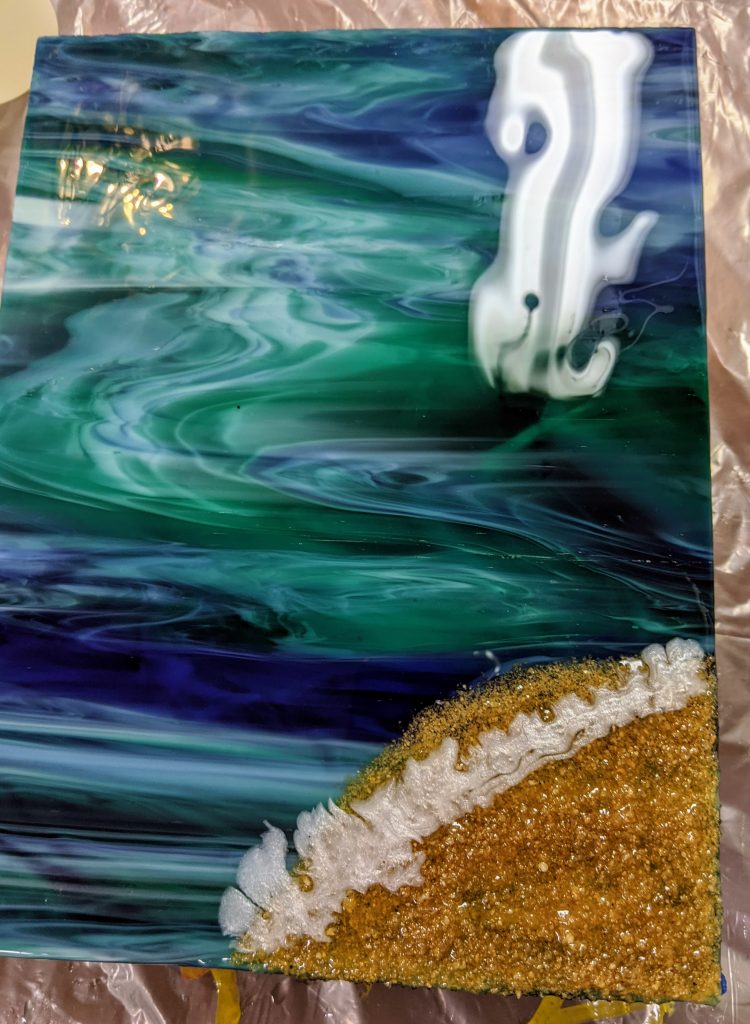
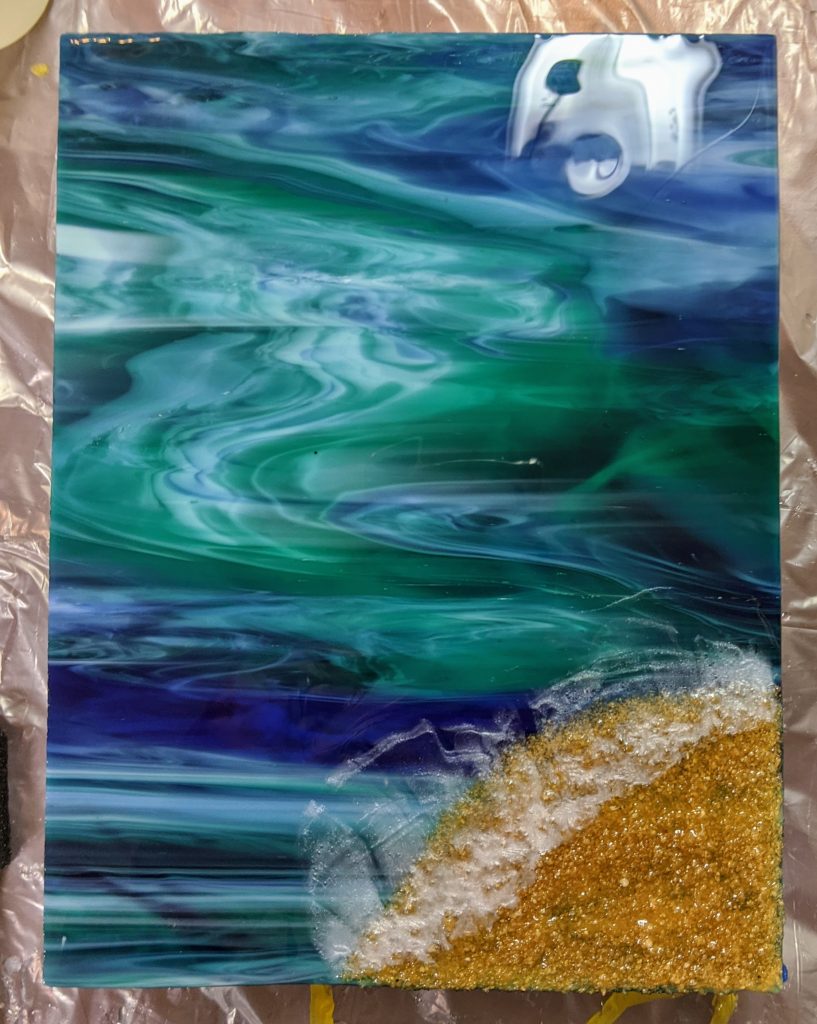
Next I used my craft torch to spread out the white bubbles of the wave. The alcohol ink drop helps create the feathery effect in the resin when the torch hits it. I really only wave the torch very briefly over the white resin one time. The torch can quickly crack the stained glass if it gets too hot.
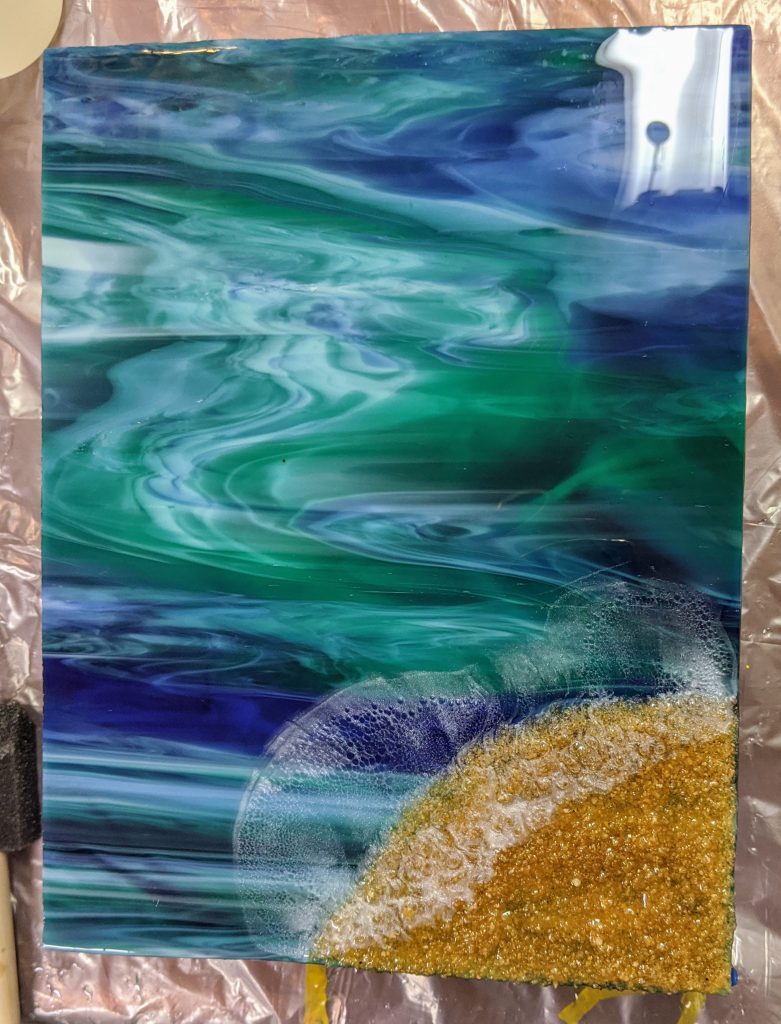
Next I poured the leftover clear resin into the coaster molds I started two days ago. The first layer was clear with some metallic flakes and a drop of blue alcohol ink. This layer was clear with about three drops of blue ink, which I added directly into the clear resin after I poured it into the molds. Afterward, I blew it with my heat gun (obligatory bubble removal) and manipulated a bit with a small craft stick.
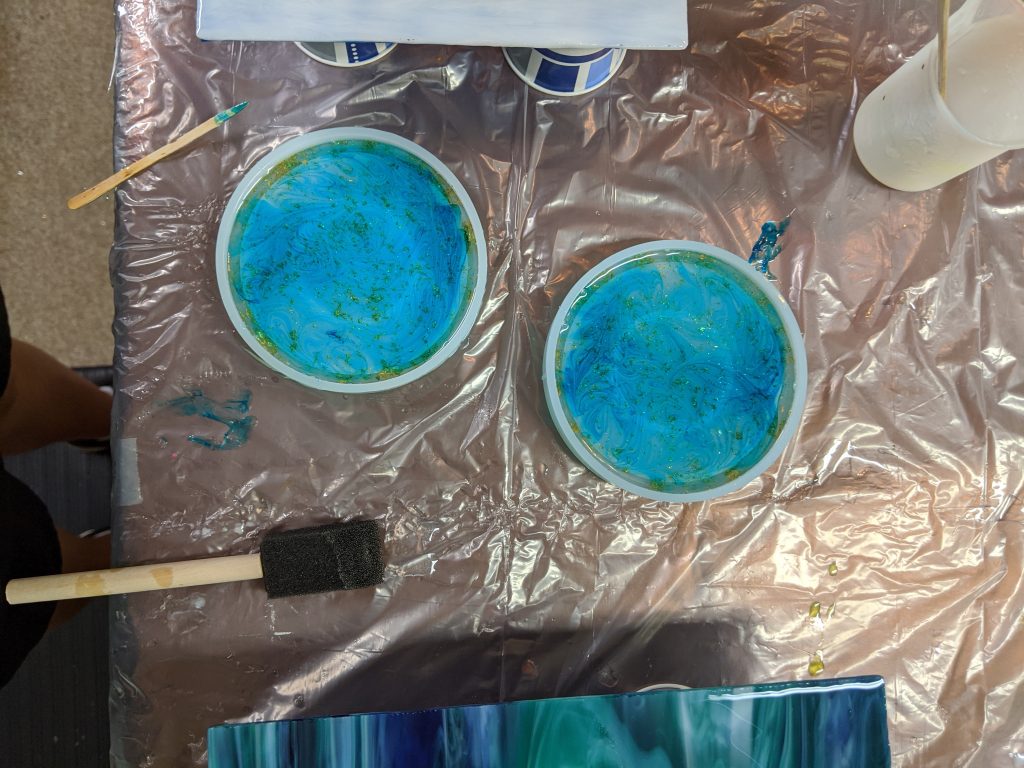
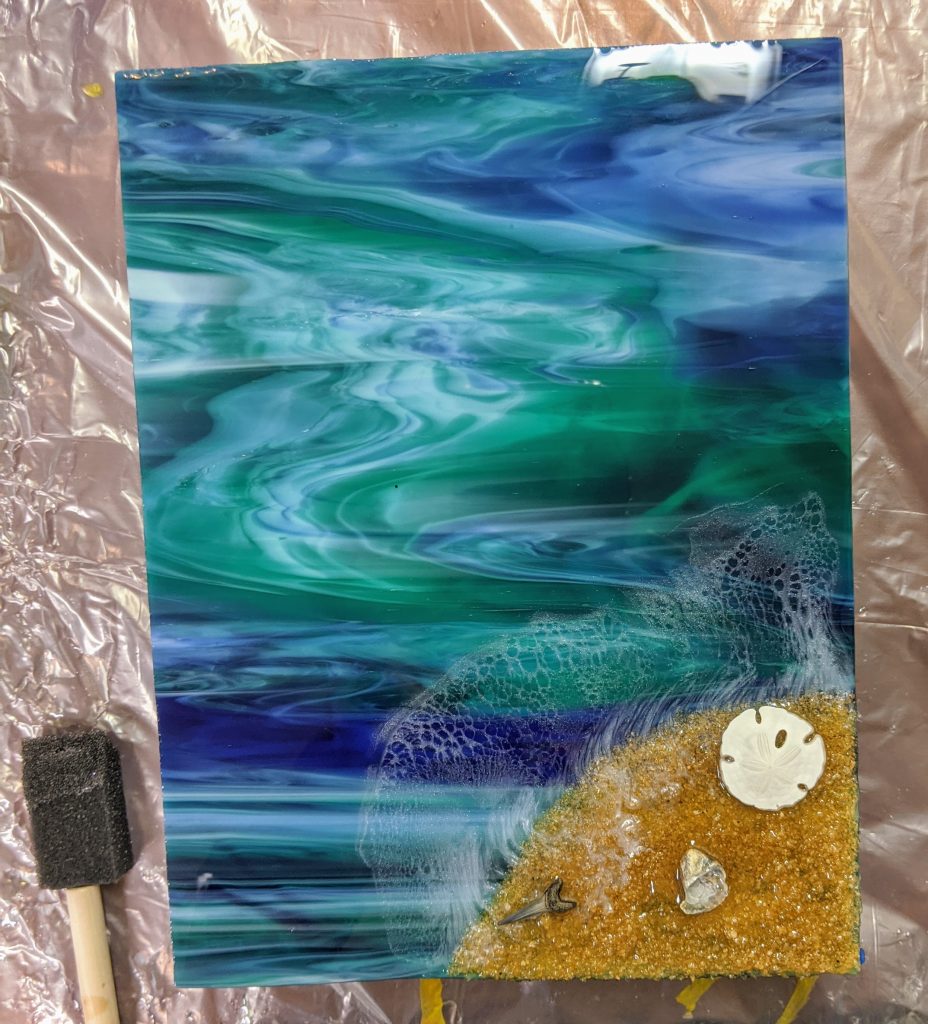
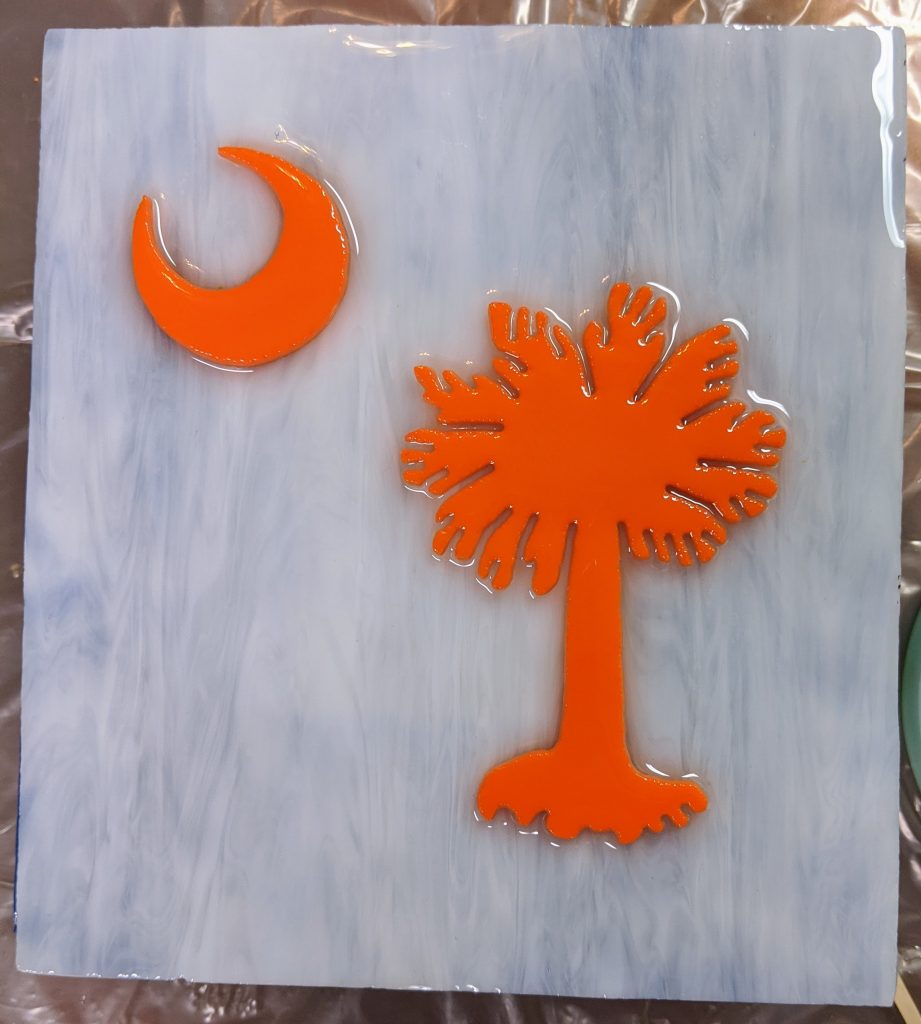
I will likely need to add another layer of clear resin to the coasters and I’m hoping to add two more layers of wave to the beach panel, but the palmetto and crescent panel should be all set tomorrow afternoon. I will probably also brush a very light coat of resin over the sand dollar, shark tooth and shell on the beach panel.
Today I decided to try something new – resin on canvas. I have several project ideas in mind, but I really need to figure out the basics for this, as I’ve never worked on canvas before. I got some black canvas mounted on wood for this – meant to get white, but saw the black and decided on a whim to try it. I probably should have gotten white too, but I had a coupon for a discount on one item and was too cheap to get both… It was definitely a learning adventure. I also had a few Palmetto and Crescent glass panels ready for resin, so I laid everything out on my work surface.
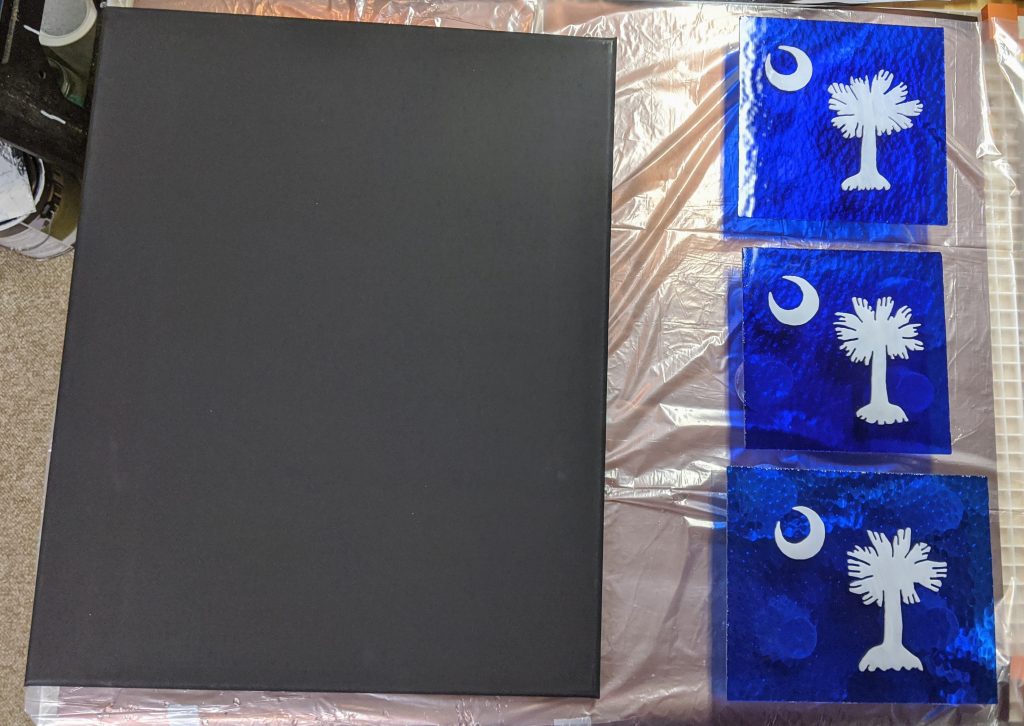
As usual, I elevated my glass panels on some plastic medicine cups. However, the canvas I just placed directly on the plastic. The secret is I added a couple of silicone mats underneath the canvas to keep it from drooping under the weight of the resin.
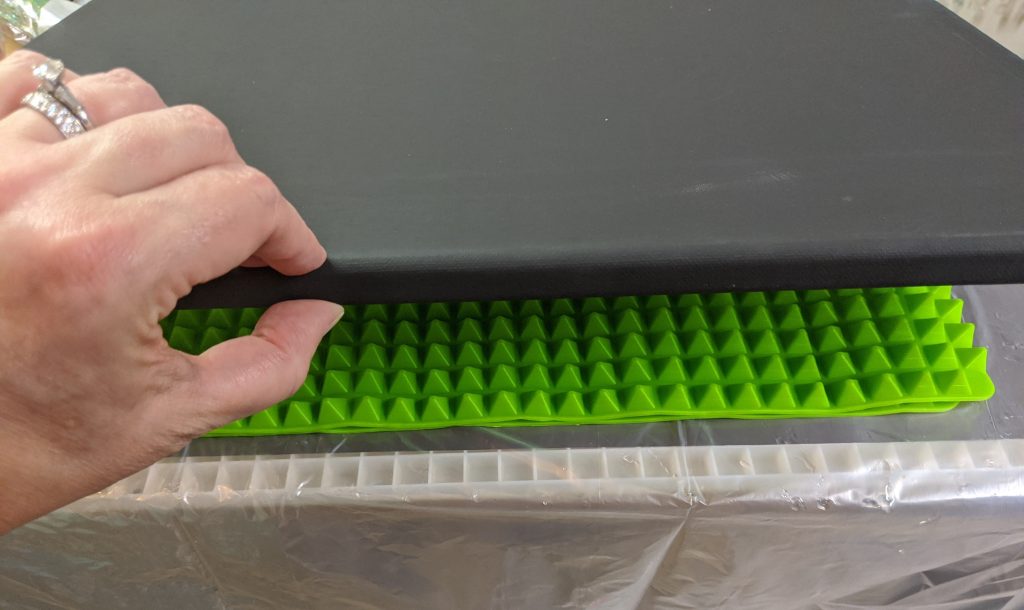
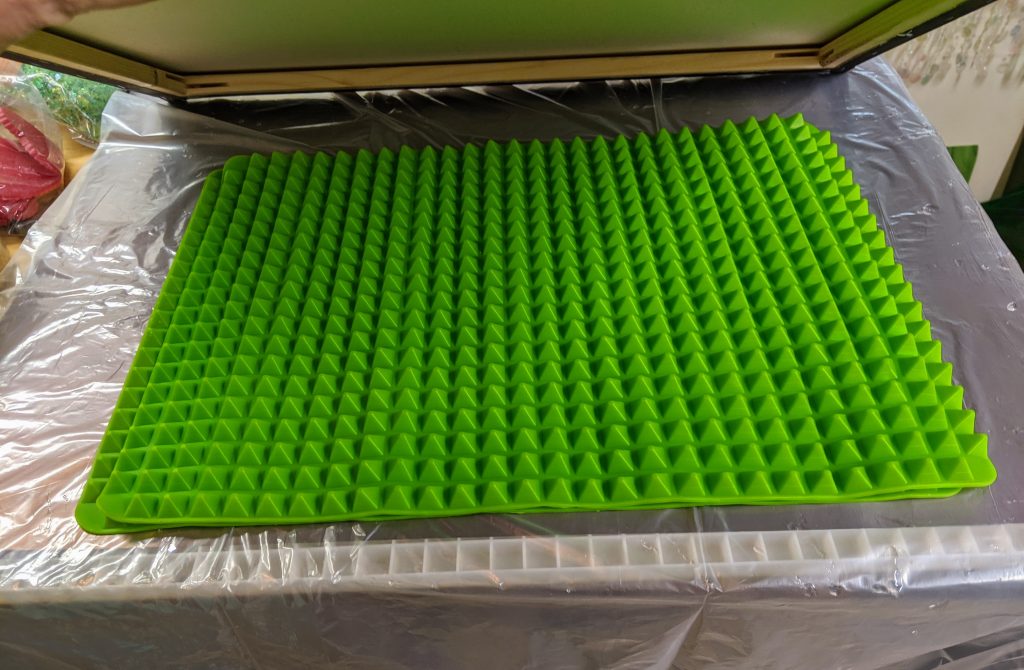
I prepared my containers and pigments for the resin and planned to mix 8 ounces of resin for all four projects. I initially wanted to use alcohol inks for the colors on the canvas and mixed a larger amount of blue for the canvas background, then some green, yellow and orange in smaller silicone containers. This project is very experimental, so I wasn’t sure where it would lead.
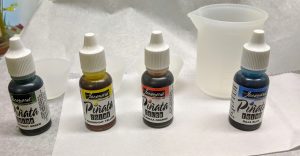
Well, I mixed each color, added a drop of white for opacity to the green, yellow and orange and a drop or two of black to the blue for the same reason. The green turned blue, so I added a couple of drops of yellow, but wasn’t really able to overcome the blue. I then spread the larger amount of blue on the entire canvas (I was going for a dark blue background) and used my heat gun to remove bubbles and even out the resin. I also added some glass chips to two of the Palmetto and Crescent panels (and tended to any drips that appeared under the edges of the glass) while I was working on the canvas.
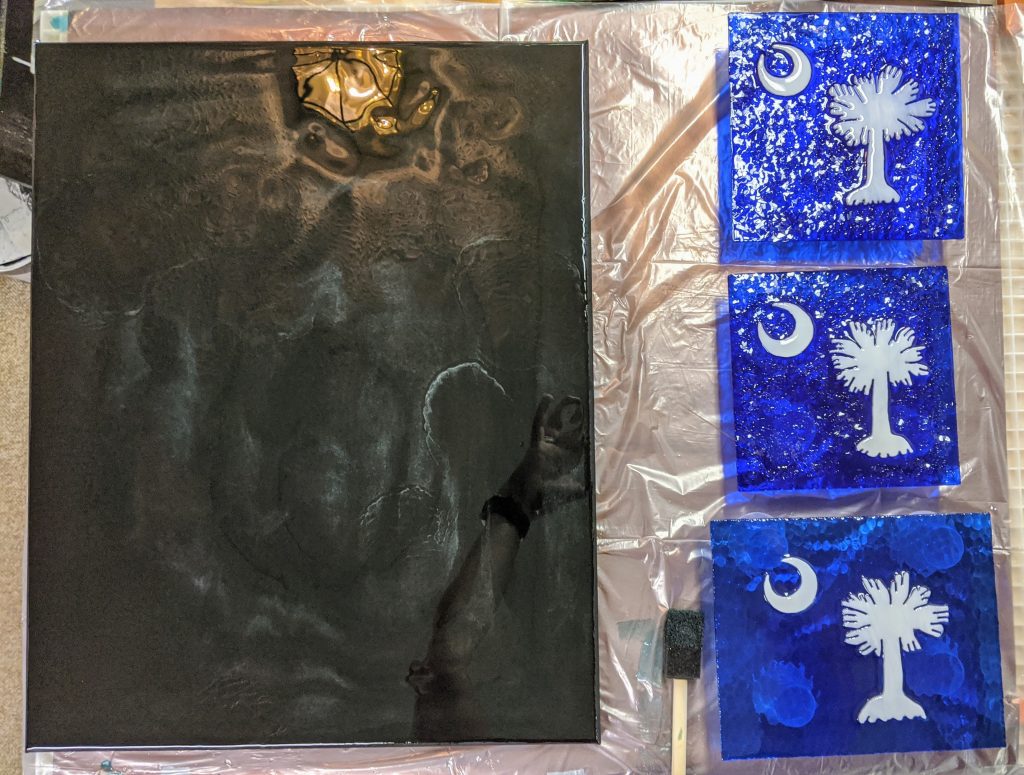
Hmm – the canvas didn’t look blue at all. I then poured some clear resin in the center where I wanted to make my design and poured the green resin on top of that, then some more white and the yellow. Well, I quickly figured out that the alcohol ink pigments don’t show up very well against the black canvas background. Whoops. I made some adjustments and powered on – mixed some white powdered pigment with the orange. That adjustment seemed to help, adding the opacity needed against the black. Next I added some powdered yellow pigment to the little bit of resin I had left and the same with some blue powdered pigment and used those. Each individual layer was hit with the heat gun.
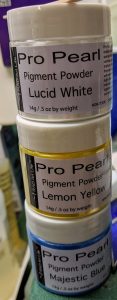
I wish I had used the blue powdered pigment on the background, but overall it turned out better than it could have. I used a craft stick to make a pattern I liked in the resin and used the blow torch to try to create some cells in the resin, but I think my resin had gotten too far in the curing process for that to work properly.
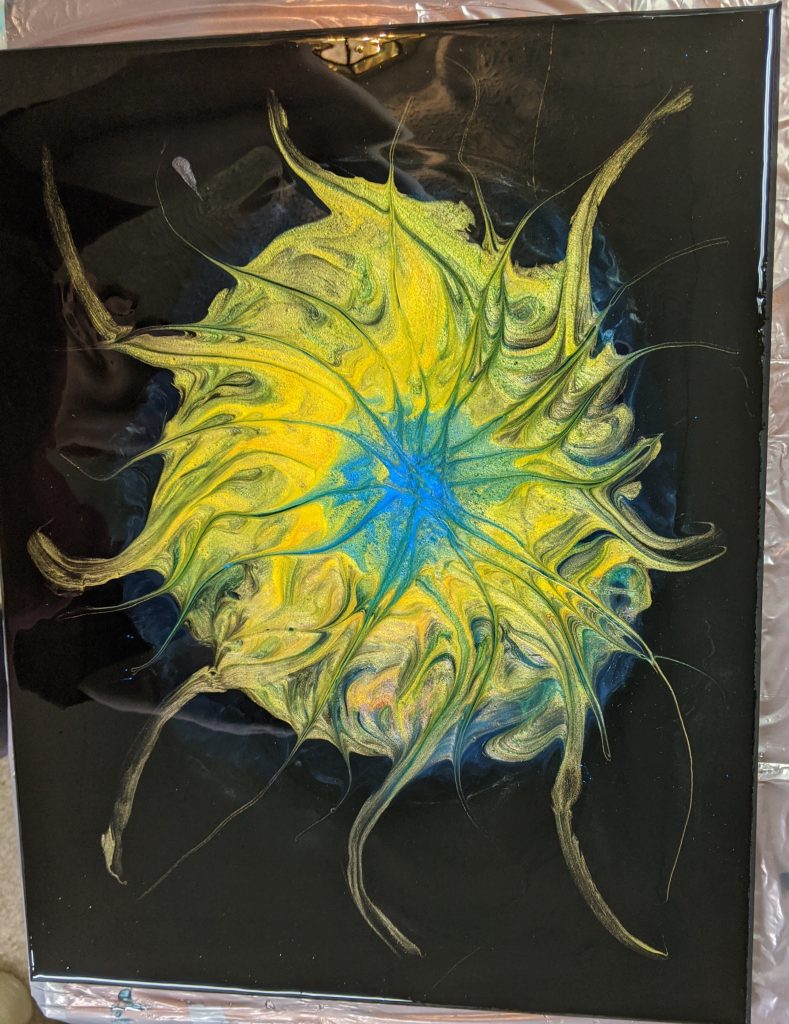
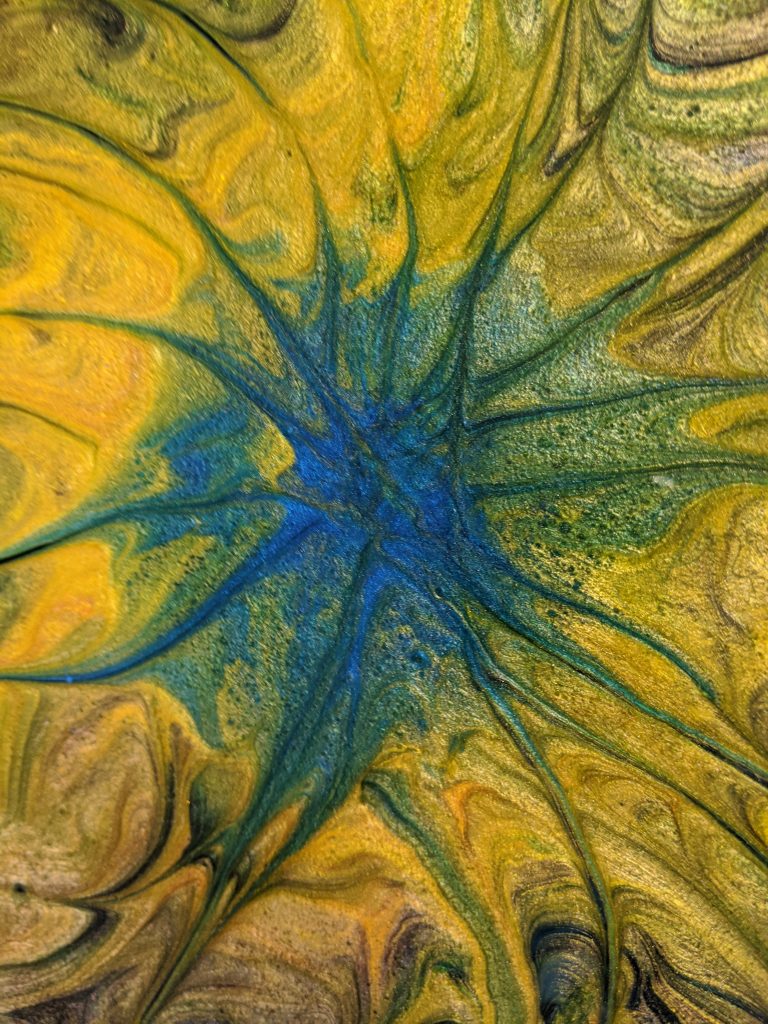
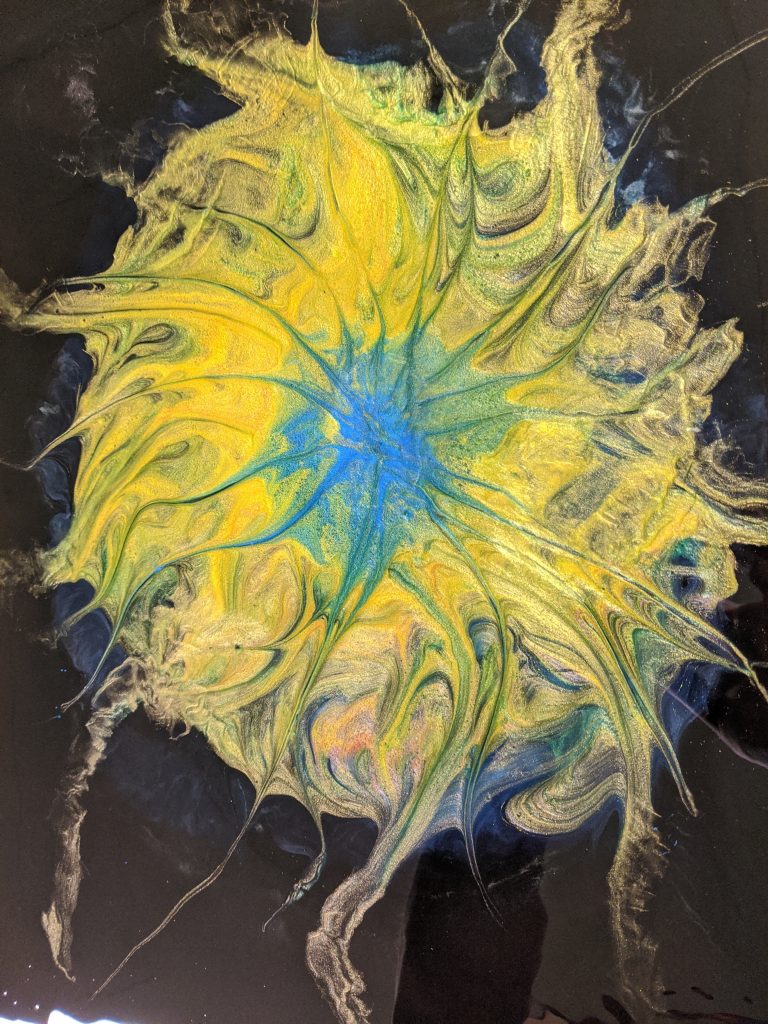
Overall for a first shot in the dark, I like how it looks. I really like the way the orange pigment adds depth to the yellow in this one. I’m not sure how it will change during the curing process, but I’ll find out tomorrow! Now I know to use the powdered pigment for my next project. It will be interesting to compare my results to this one.
Here are the six small panels I made over the past few weeks and finished yesterday. They are done curing and ready for the runway! For your entertainment while housebound due to COVID-19… 😉
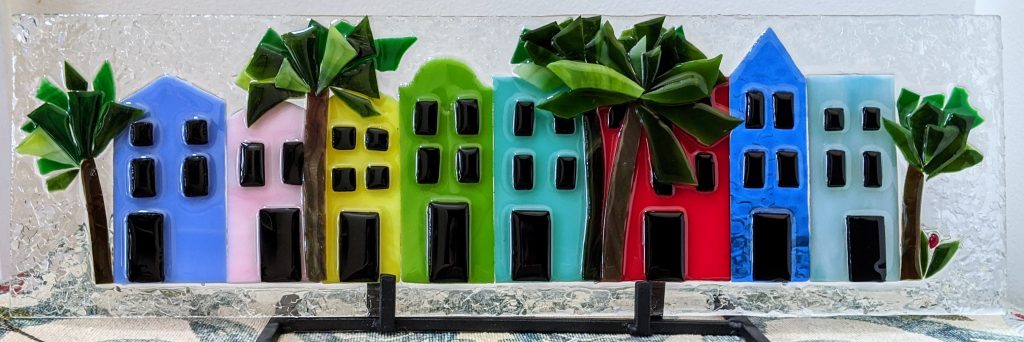

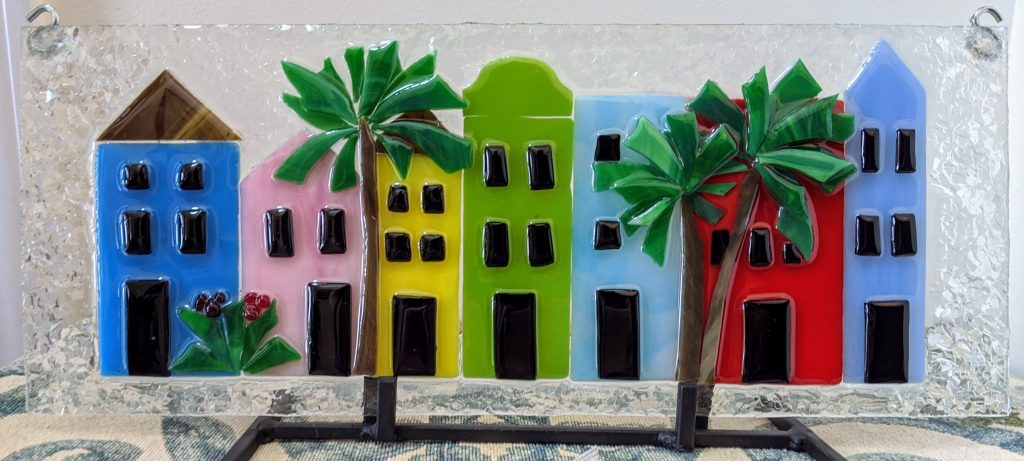
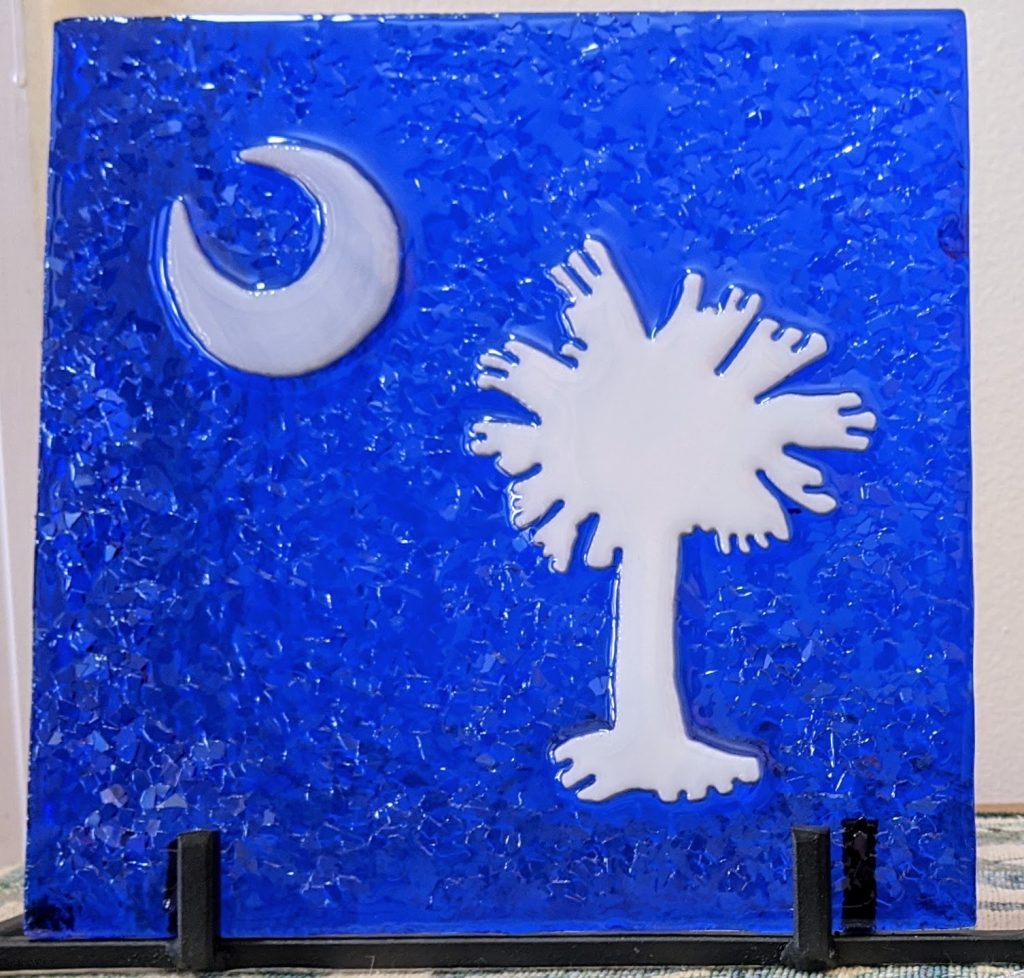
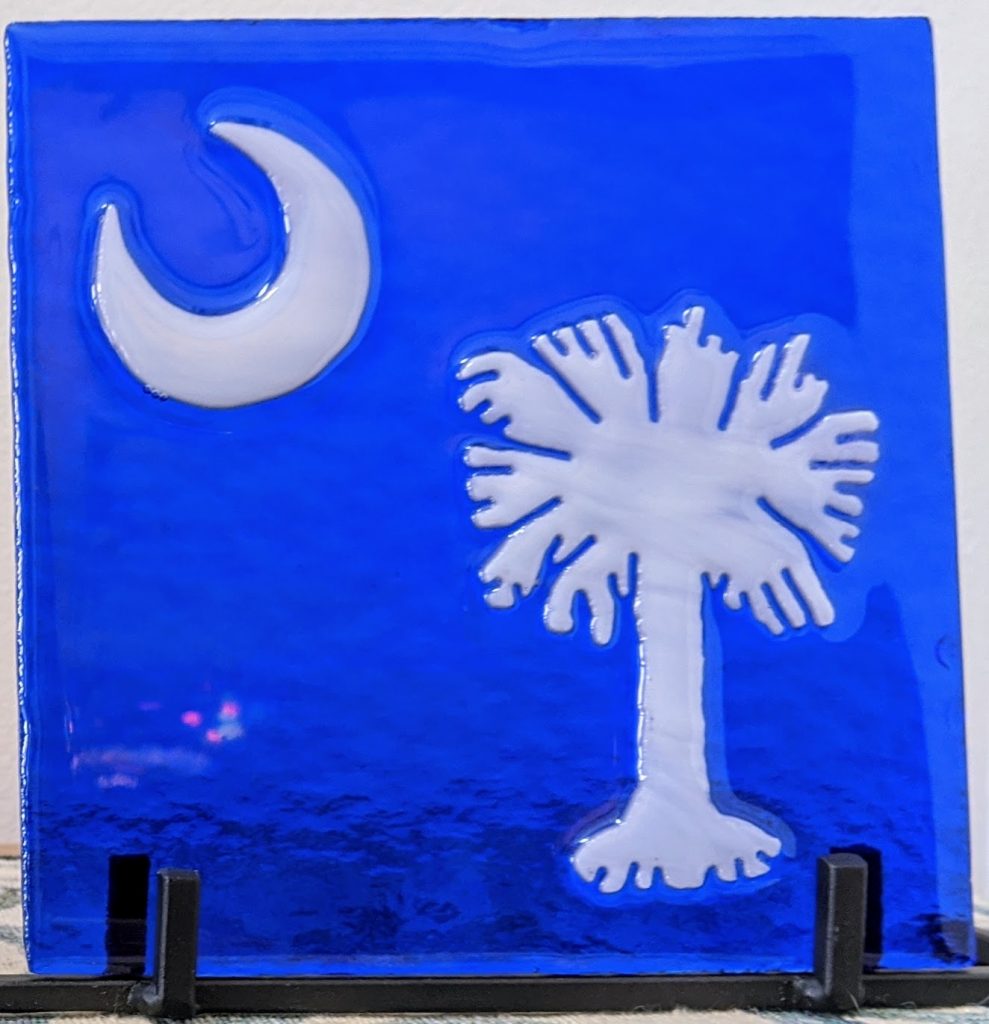
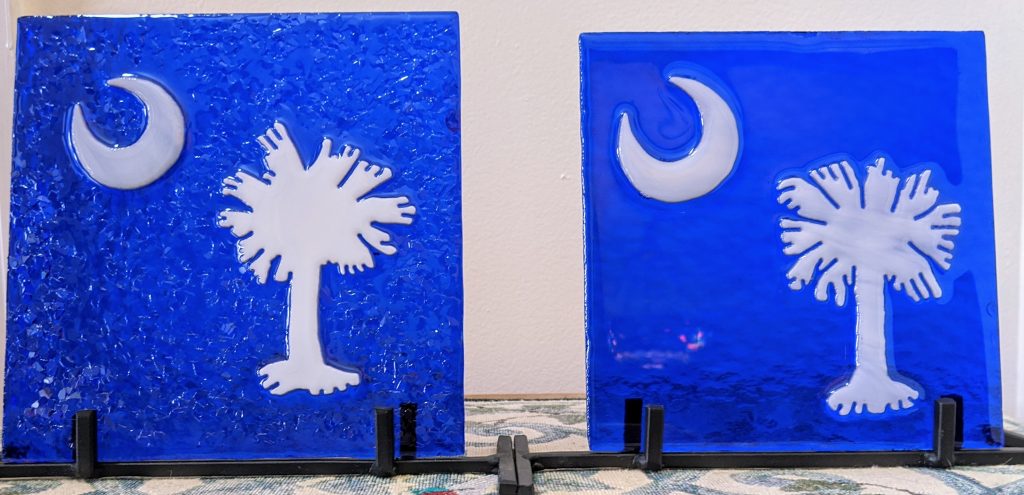
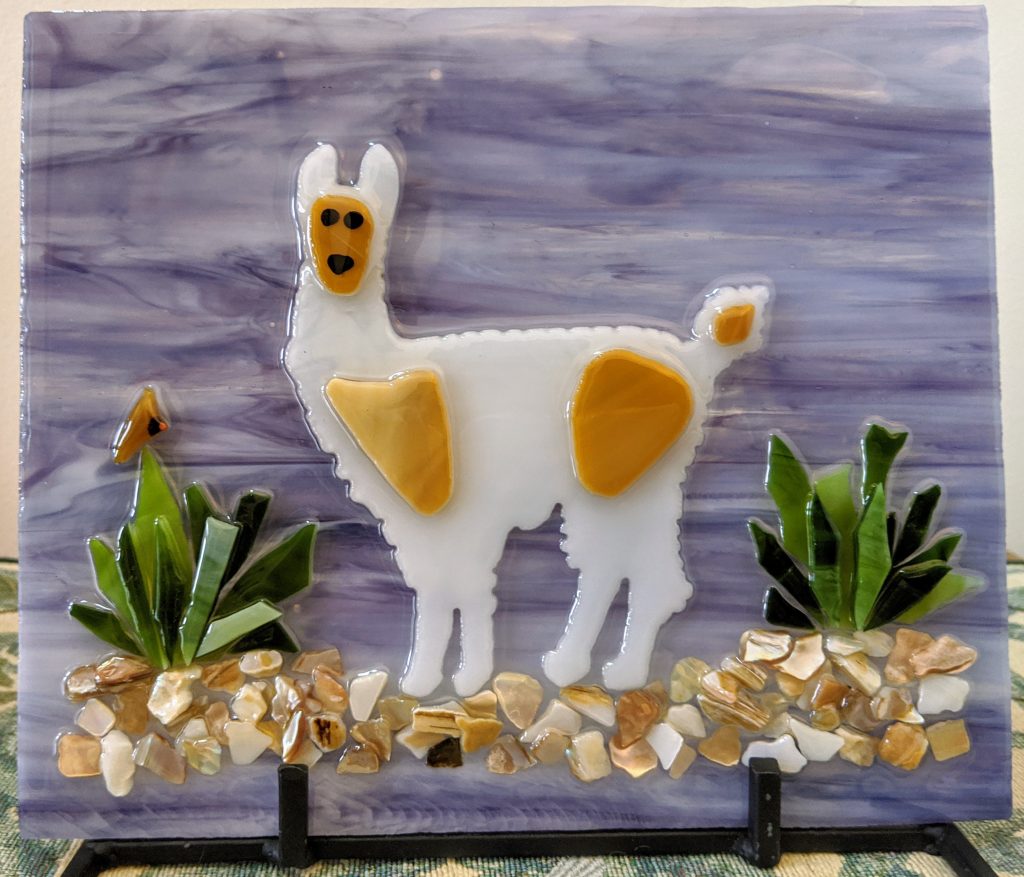
I prepped six small projects over the past few weeks and have them all ready for the resin. I’ve never tried to pour this many at the same time, so we’ll see how it goes. I mixed up 12 ounces of resin and started pouring. The best advice I can give on coating the glass is not to pour too much at once. The fewer drips you have to contend with, the easier it will be to manage. Of course, that’s easier said than done.
First, I cover my work surface (I used wrapping paper over my glass cutting board, then a plastic trash bag on top of it). I used little medicine cups (about the size of Dixie cups) to elevate the pieces over the surface.
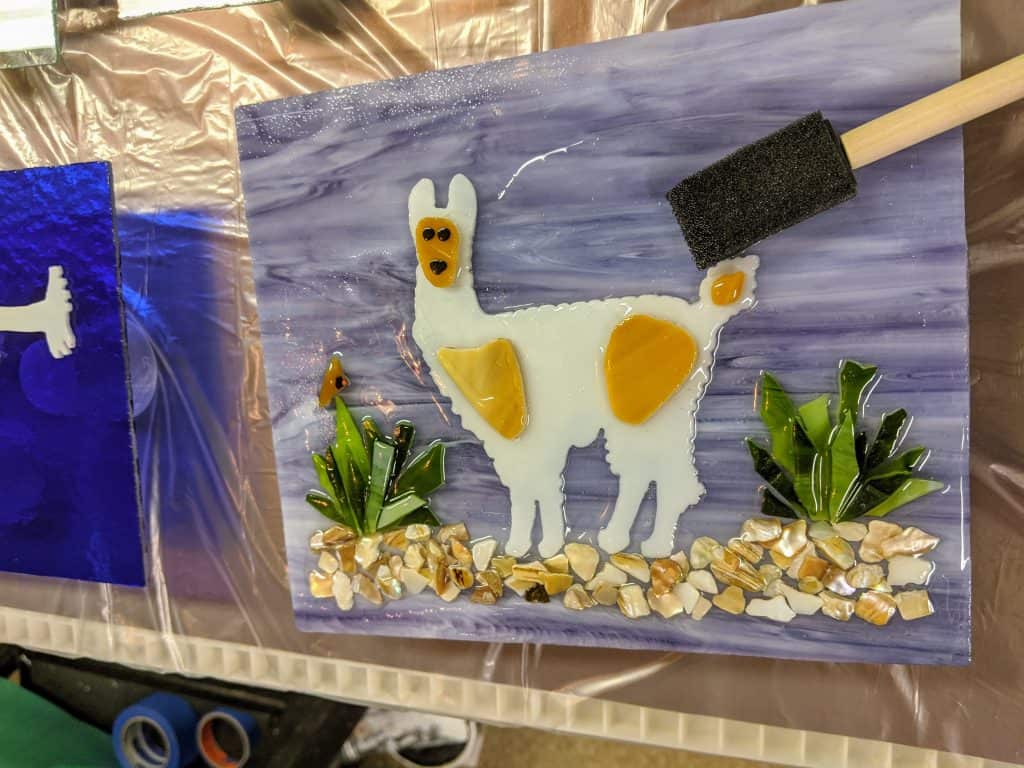
I generally try to pour the resin directly onto the parts of the piece with the most layering / texture and then spread it across everything else with the sponge on a stick. I can also use my heat gun to do a bit of spreading later.
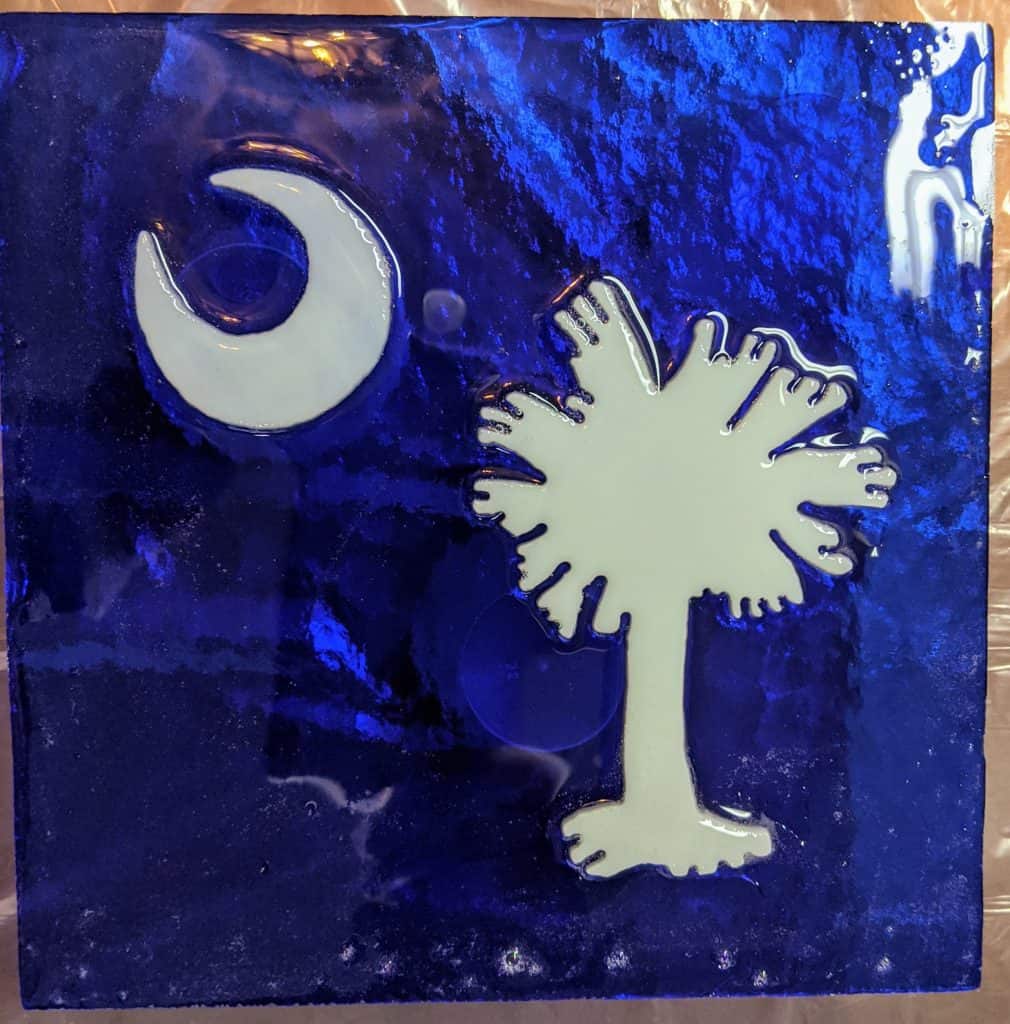
After I’ve spread the resin over the entire piece, I use the heat gun to remove the bubbles and help move the resin around to fill in any empty spots.
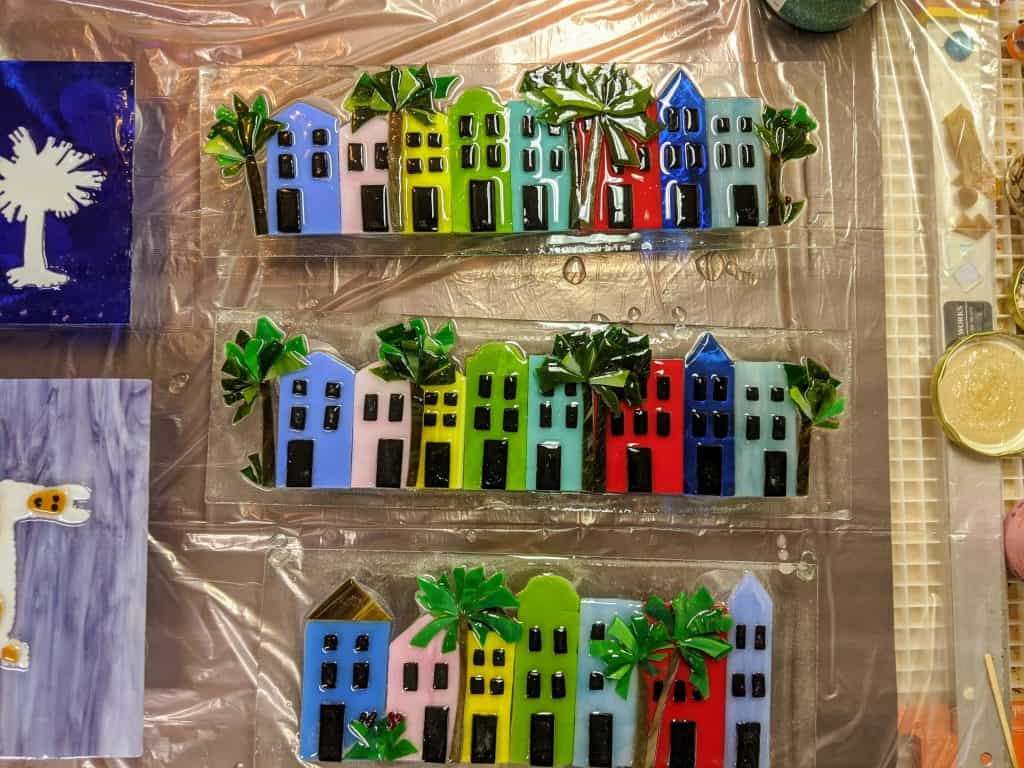
I have 6 pieces I’m juggling at once, plus I mixed a bit too much resin, so I poured some of the excess into some coaster molds I have on standby for just such an occasion. I don’t think I’ll try to finish this many pieces at the same time again, as it was a bit stressful. Having them so close together on my work surface made it difficult to tend the resin around the edges of the pieces. I think I pulled it off, though.
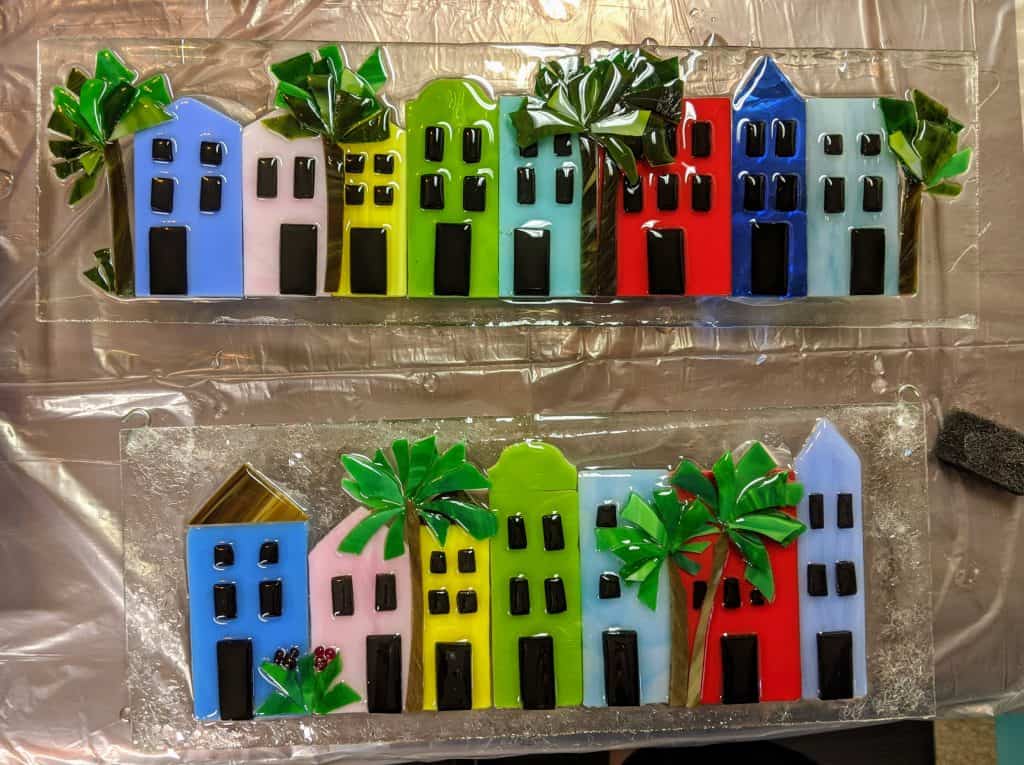
For some pieces, I like to add glass chips or other decorative items to the resin. Once the resin is poured and I’ve removed the bubbles with the heat gun, I try to remove any drips from the undersides of the pieces with a craft stick and then I can sprinkle the glass chips on top. The resin will move a little, so I use a craft stick to help keep the edges neat.
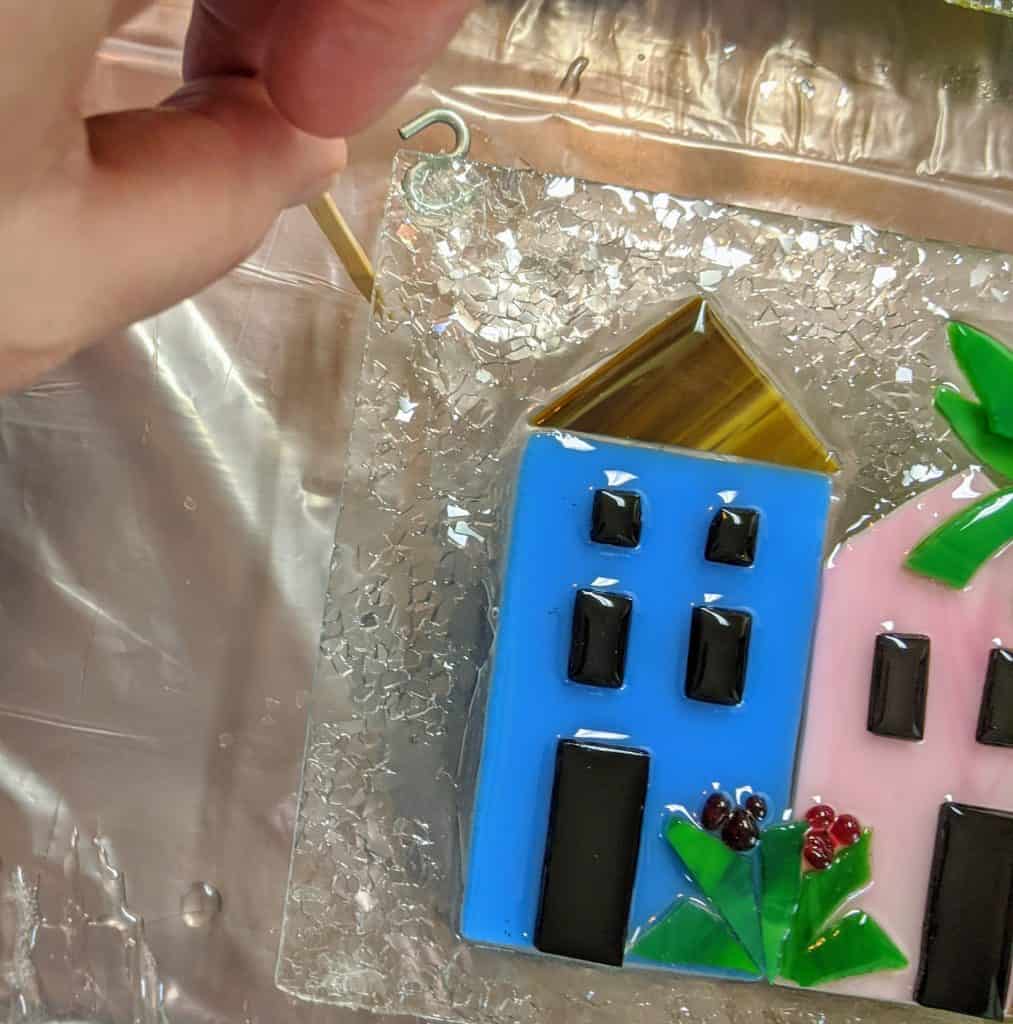
It is possible to tape the undersides of the edges to more easily remove the excess resin after it cures, or to scrape drips off afterward, but I’ve found this method works best for me. I have cracked a few pieces trying to remove drips after they have cured.
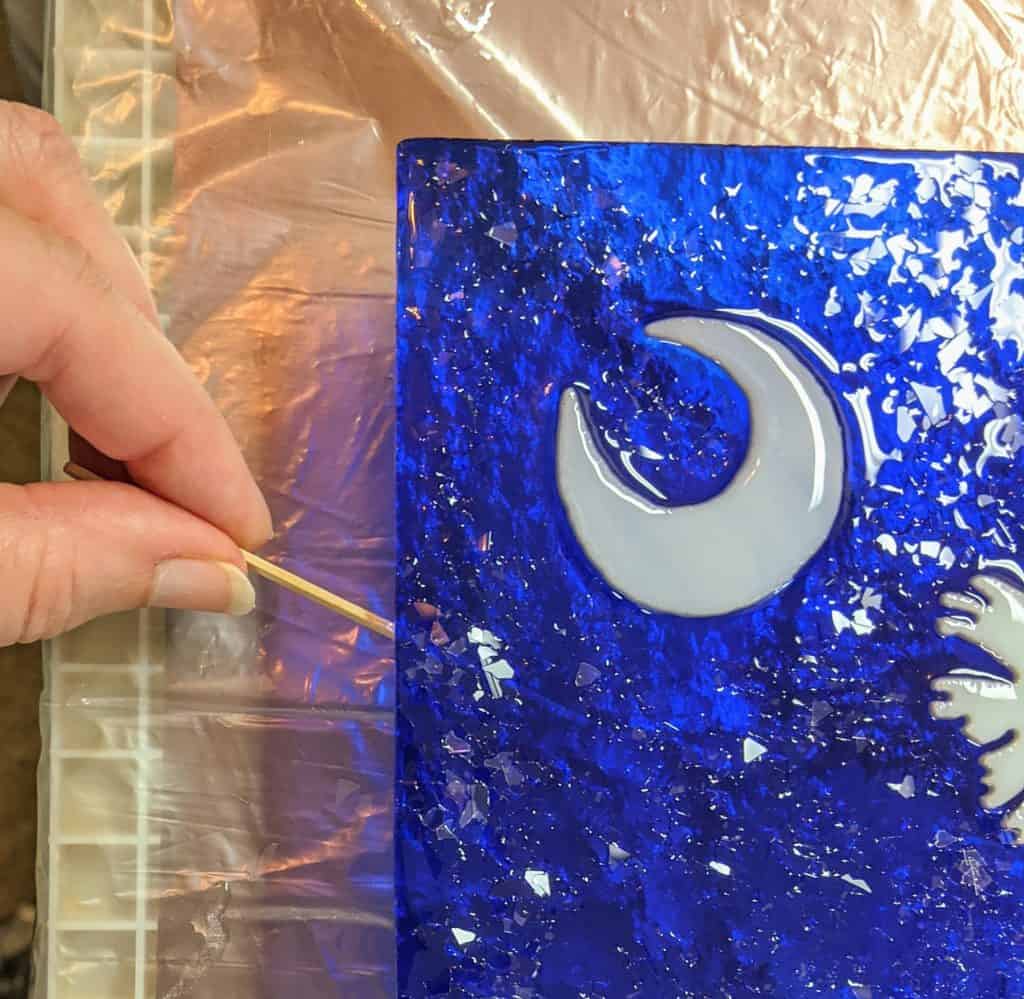
I decided to see how the glass chips would look on a colored piece. Since I made two similar SC Flag pieces in this batch, it will be a good opportunity to compare the two effects (one with and one without glass chips).
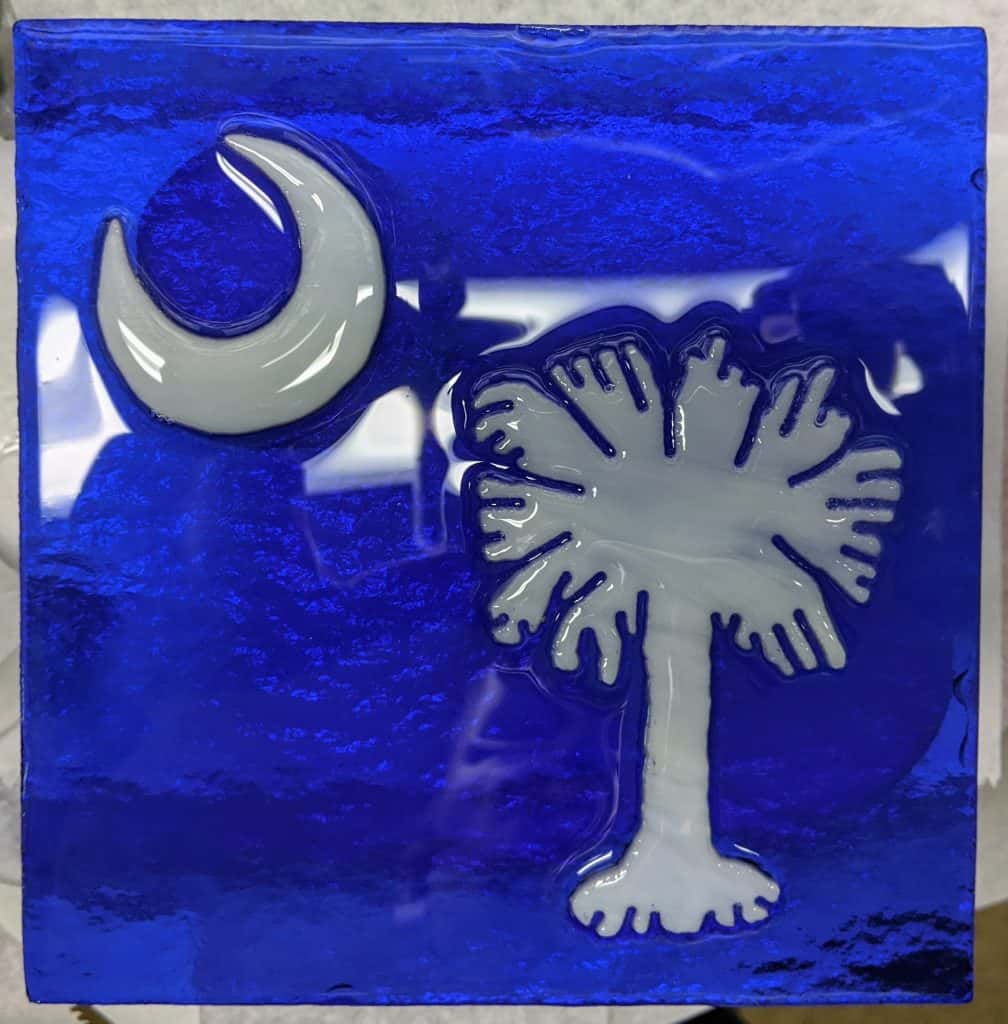
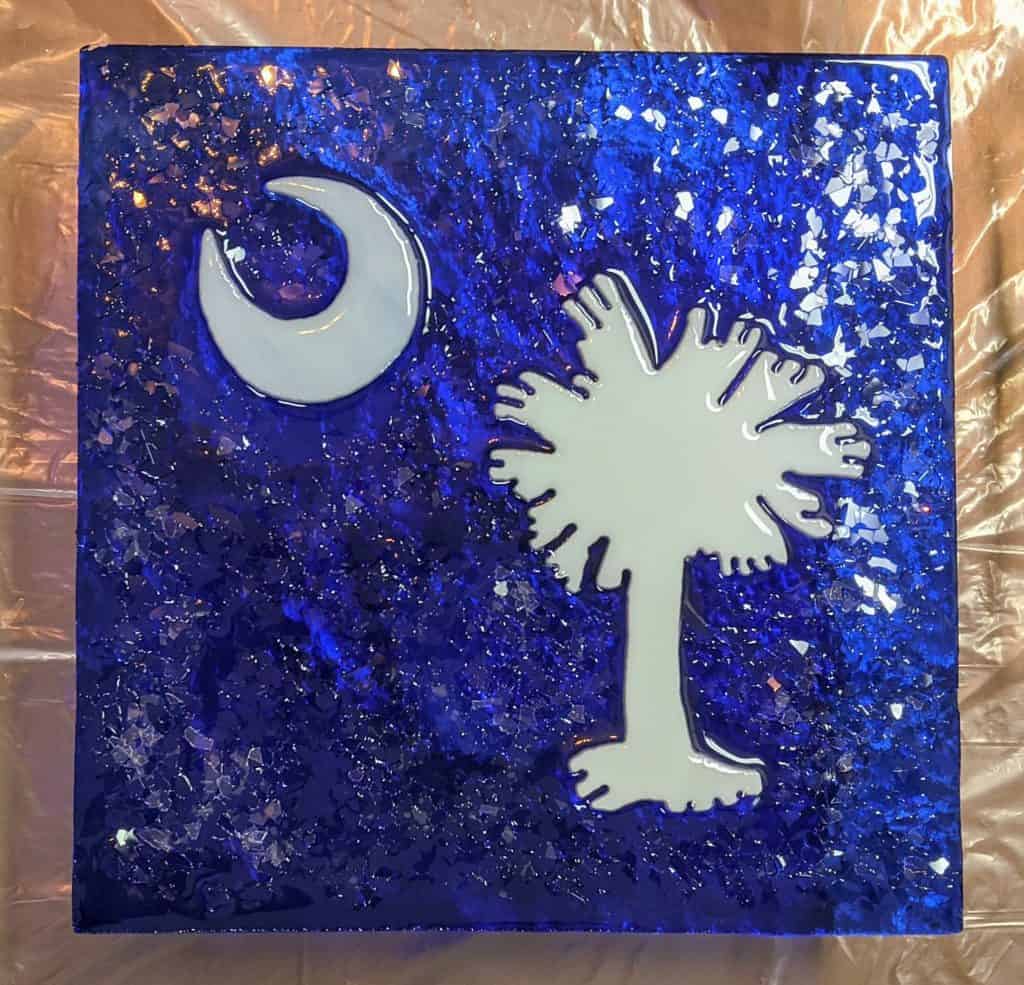

Now I have to wait overnight for the resin to cure. We’ll see how everything turned out tomorrow!
Today I put the last few touches on two Rainbow Rows and the Llama and geared up to get the resin poured on everything. I’m still not sure about the Llama – need to decide if I like it with or without the little bird (why am I obsessing over such a small detail?).

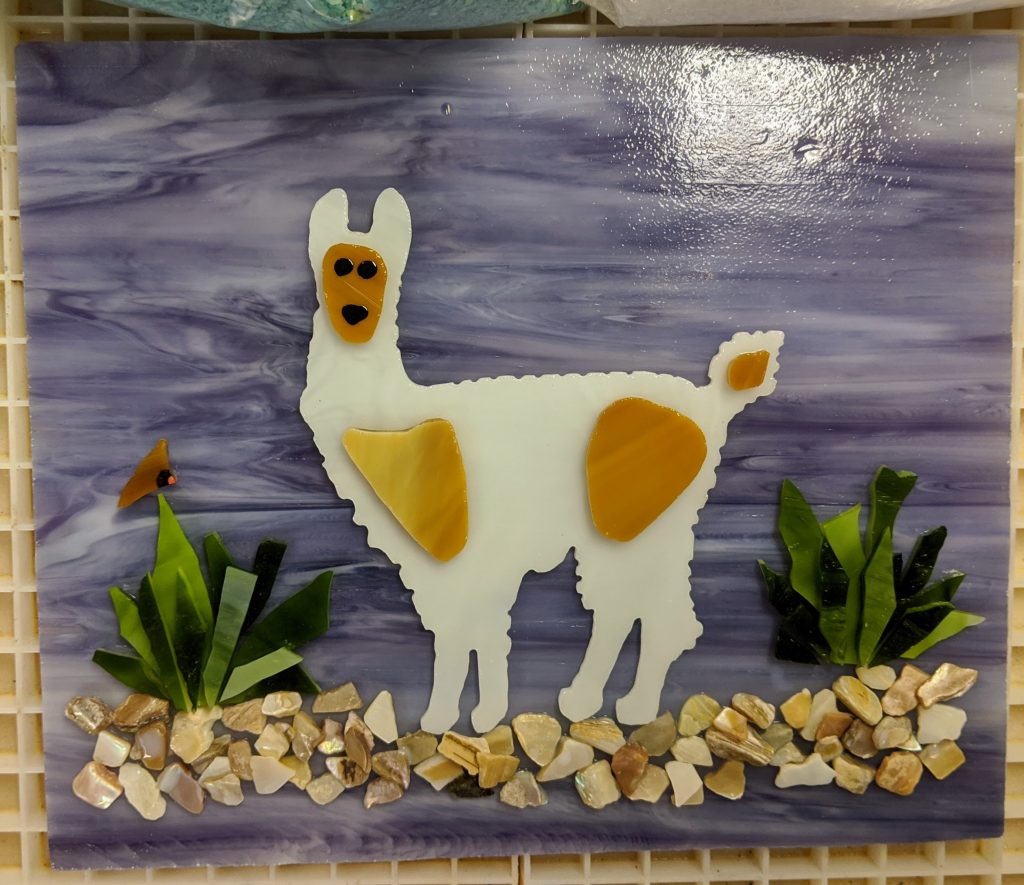
I also added several more palm fronds (leaves) to the palm trees on my two Rainbow Rows, and some grass on one and a little tulip type flower on the other. I think I’m ready to resin these, as well as the SC flag I made the other day.
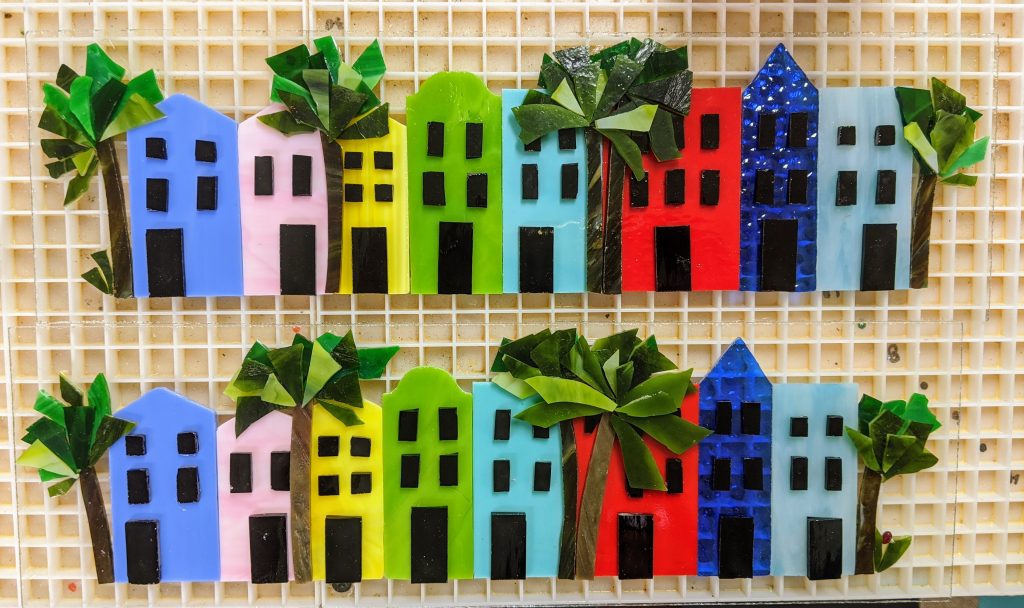
I have two more blue backgrounds cut for additional SC flags, so I thought I would go ahead and cut out the trees / crescents to go on them. However, after finishing the first Palmetto tree and starting on a crescent, my saw had an orange grommet failure and that halted progress on anything that requires the saw for a few days until I can get a replacement part and (hopefully) repair it. I say hopefully because I’m hoping only the orange grommet failed and I can get away with just swapping it out – but there could be other things going on that I haven’t noticed yet. Ah, the joys of using a ring saw!
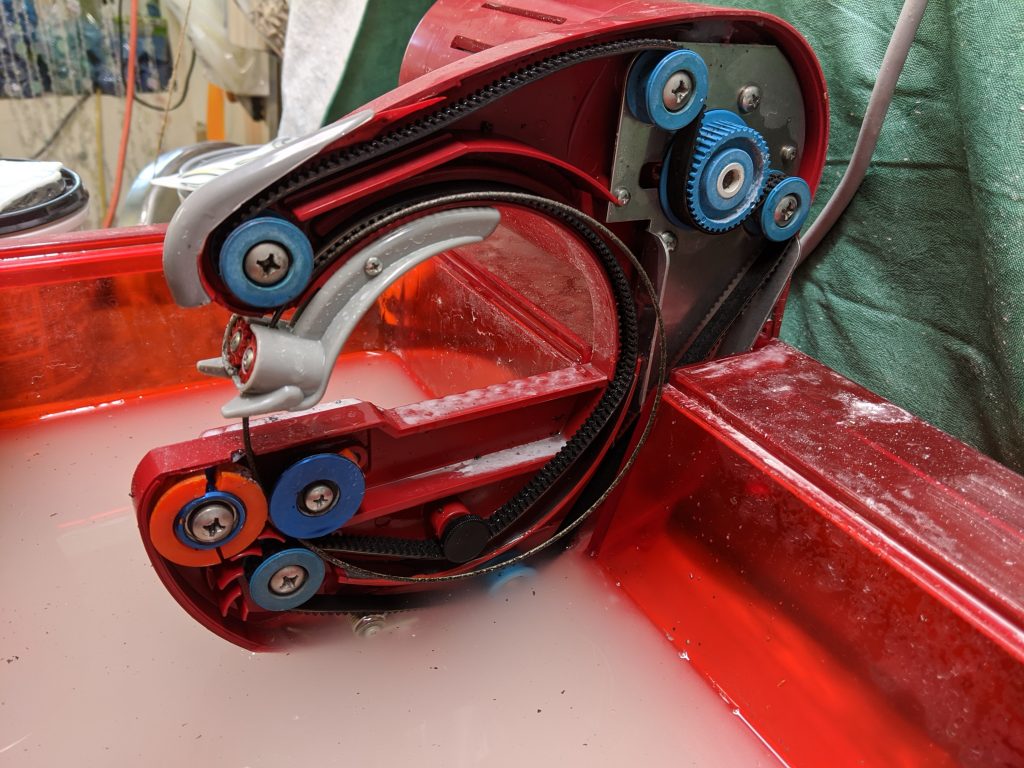
My saw is a Taurus 3 and is many years old. I haven’t used it regularly in recent years and I probably should just replace all the rubber parts inside. I need it for projects like the Llama and the SC flag. For most of my other projects I generally cut the glass by hand and use a grinder to shape / smooth the pieces. I was able to finish up the crescent I was working on by hand cutting and then grinding the glass.
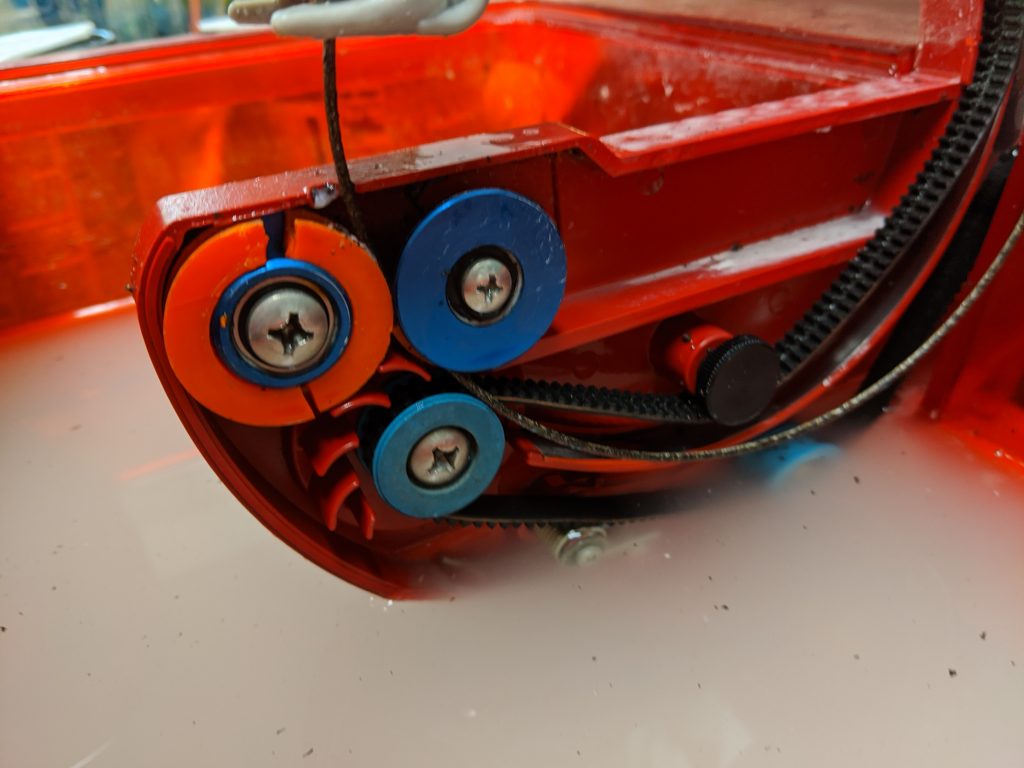
At least I can pour the resin on these projects while I wait for the replacement parts to come in the mail.
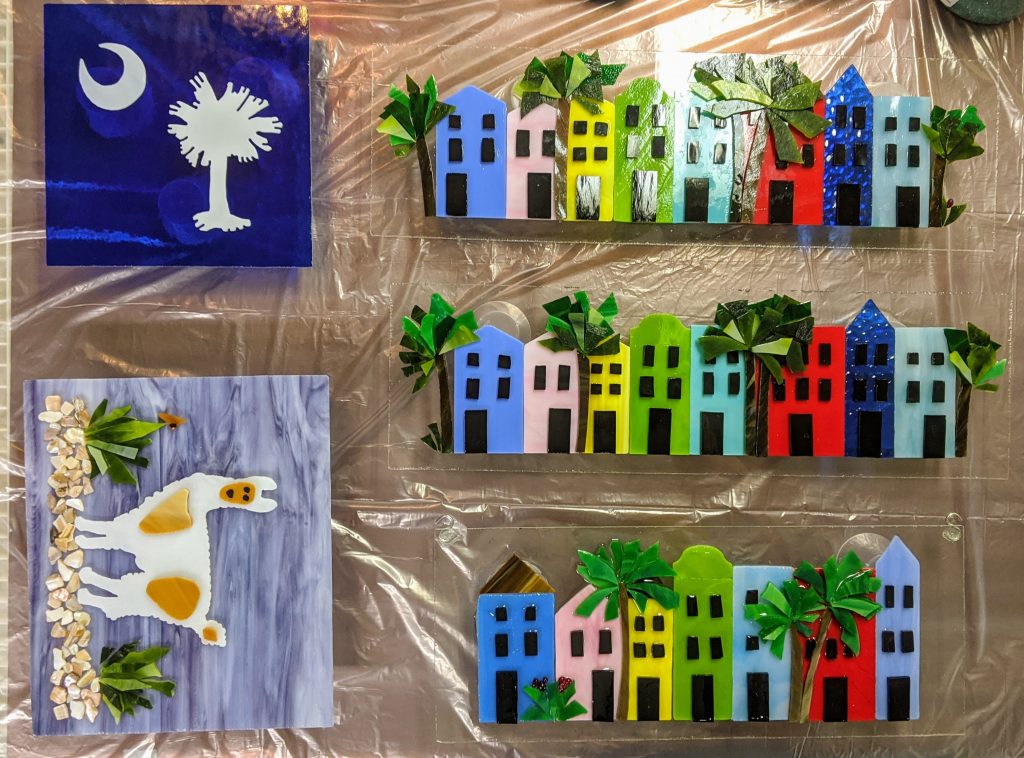
Today was a multitasking day. I have several projects going on at the moment: three rainbow rows (one just waiting for resin), two SC flags and an unexpected….llama? I’m also planning another resin/canvas project that will be a new area for me to pursue. So… today I glued down the SC flag I had cut out the other day:
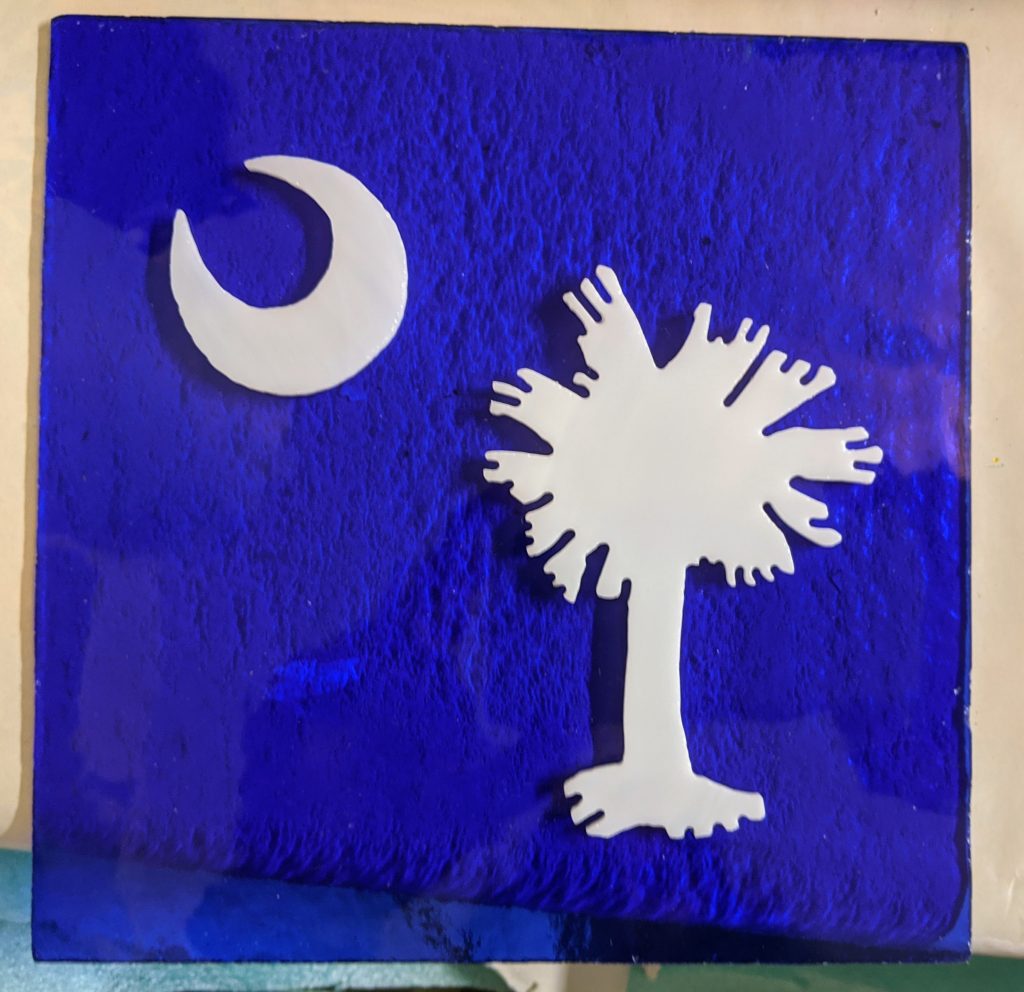
Next I decided to try out a new stencil I got this week. I have not used stencils before, so this is a new direction. I’m going to try painting the flag design on the glass and then coating it in resin. I think it will take several coats of paint, though.
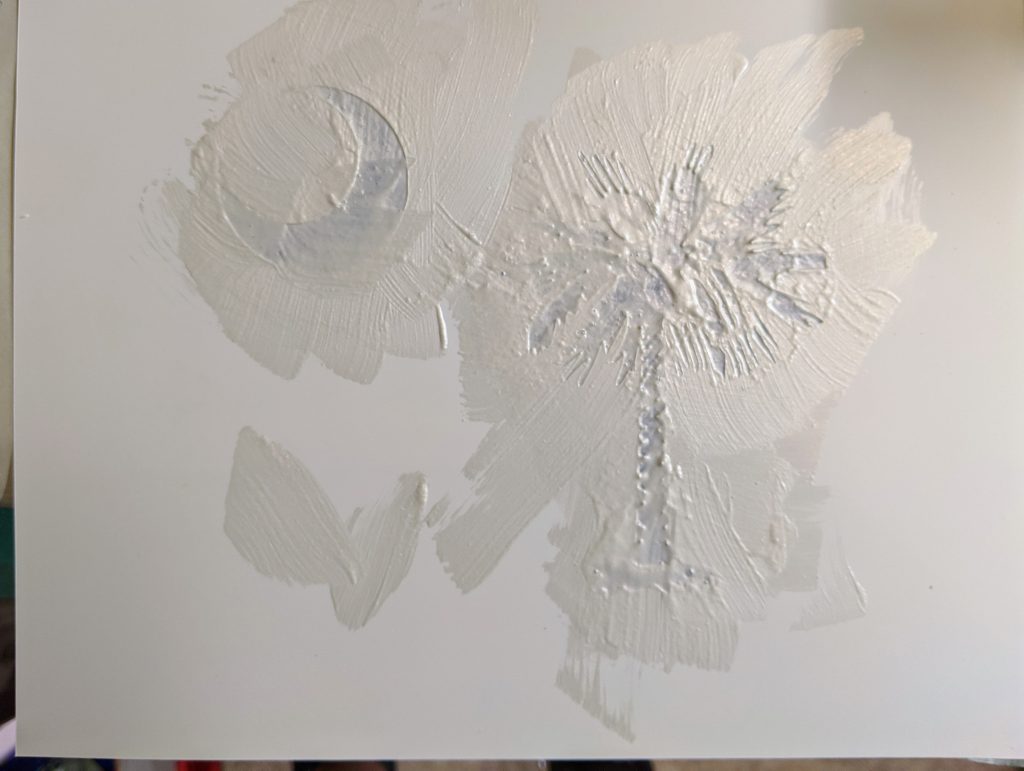
Next, I needed to glue down the tree trunks, windows and doors on these two Rainbow Rows as well as fill in the palmetto leaves / fronds. These two have one more house than my first two because I had a longer piece of backer glass. I got all of those glued in place this afternoon:
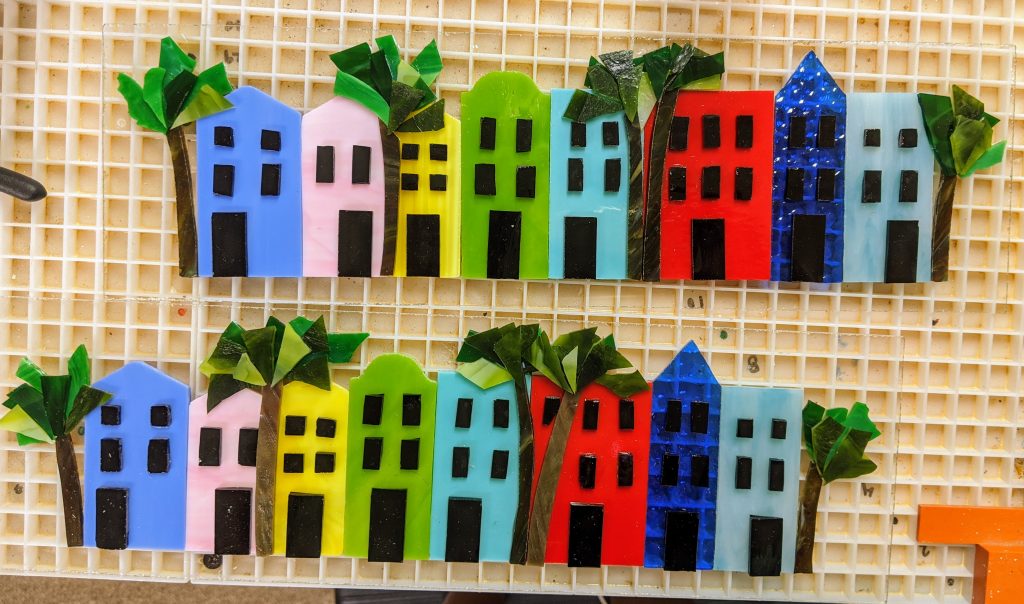
Finally, I had a request from a friend to make a Llama….with purple. Hmm. I have a couple of different shades of purple glass, and she chose the darker shade. In the meantime, I googled pictures of Llamas, printed one out and traced it onto some white glass. I coated the marker lines with mark stay because I needed to use the saw for this level of detail.
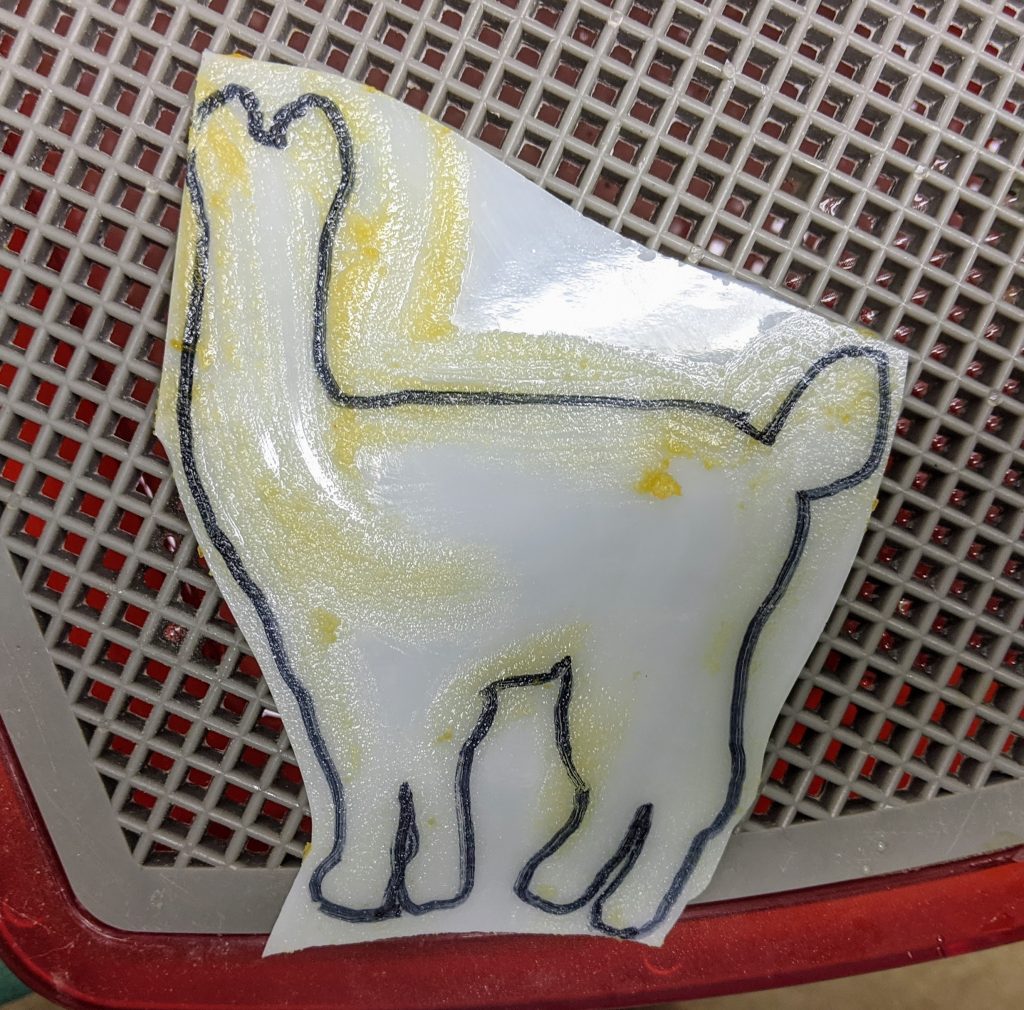
First I cut the Llama out, then I went back and made the “fluff” around the edges of the Llama with a second pass with the saw. My friend indicated that she likes lots of colors, so this Llama is going to have some spots. Tomorrow I hope to be ready to glue him / her to the purple art glass background and then I’ll have several items ready for resin.
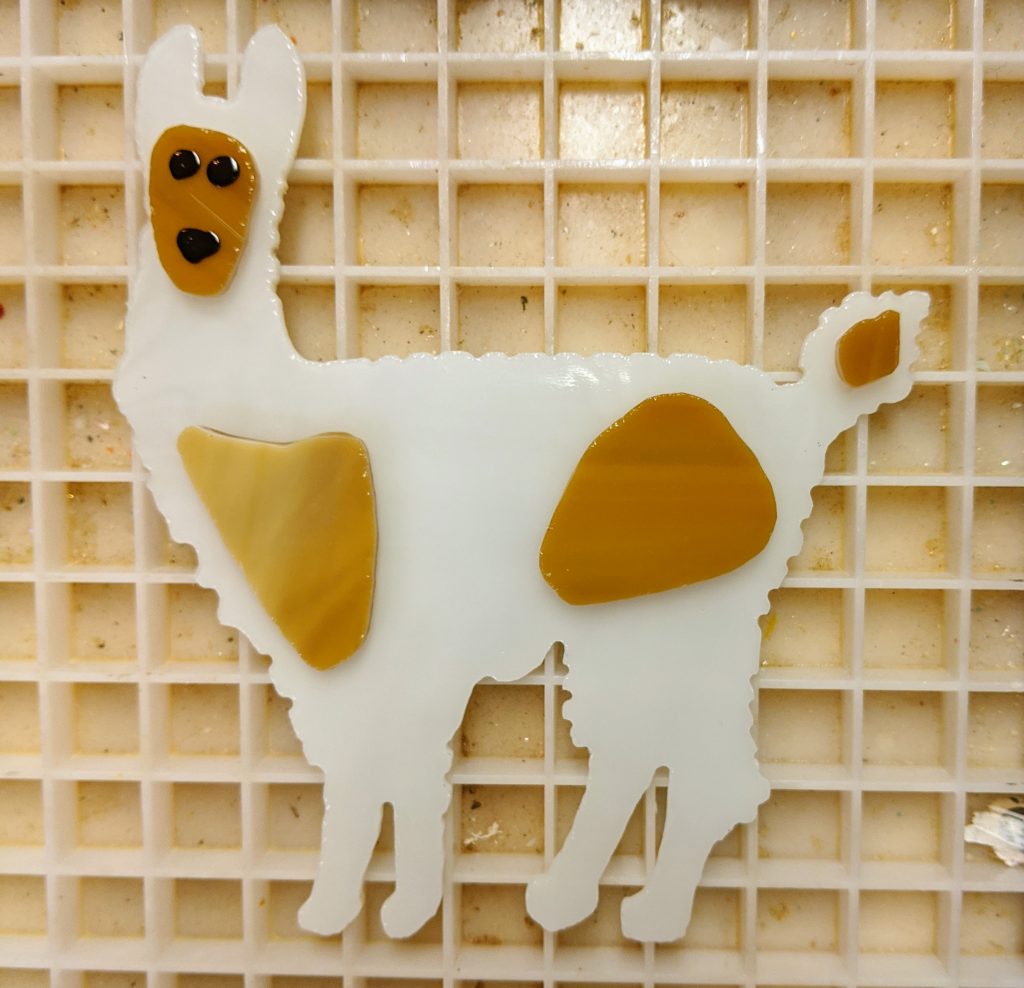
If I ever make another Llama, I think I will make the spots fuzzy like the outer edges of the Llama. I already glued these spots in place, but I may try to pry them off tomorrow and fluff them up a bit.
Today I did some cleanup in my work area (vacuuming, organizing, etc) in preparation for a new project I’ve been thinking about doing for the past several months. I’m going to make a small (approximately 6″x6″) version of the South Carolina flag. Yesterday I went through my glass and selected some blue for the background, then cut it into squares. I also printed out some pictures of the flag I’ve used for past projects in the right size and laid things out.
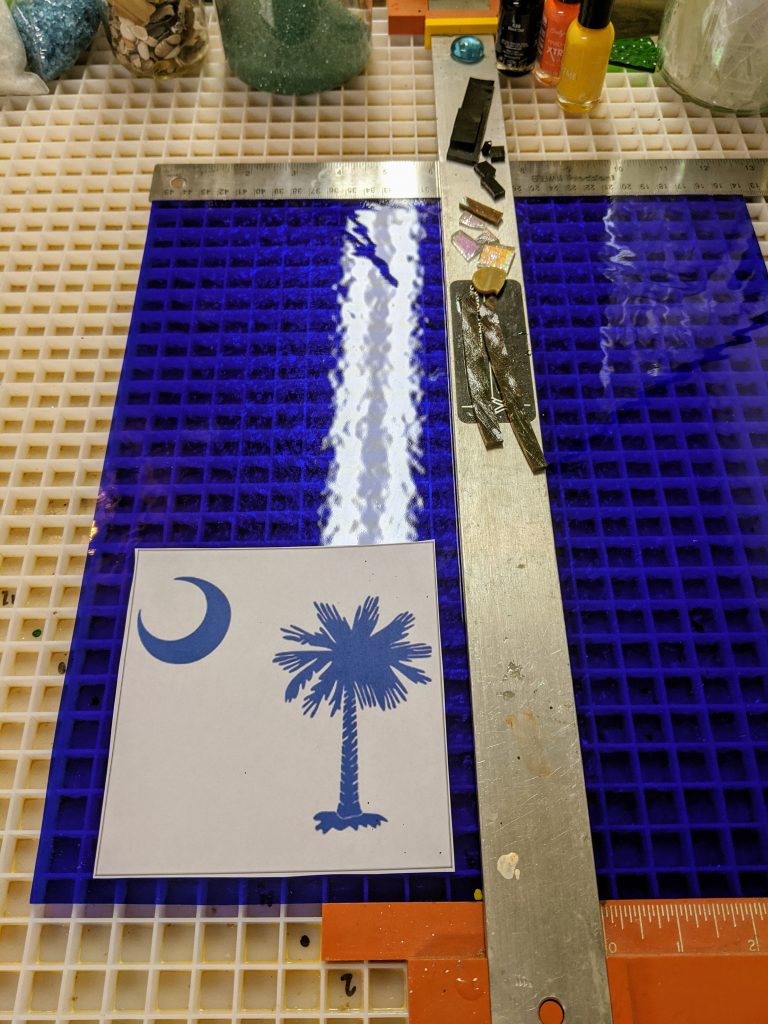
I was able to cut four squares, between 5-6.5″ each, from this one sheet of glass. Then I traced the outline of the Palmetto tree and crescent onto the background piece. Next I used my mosaic nippers to cut a large selection of tiny pieces of white glass from some scrap glass I have on hand. Then I set about arranging them into the image.
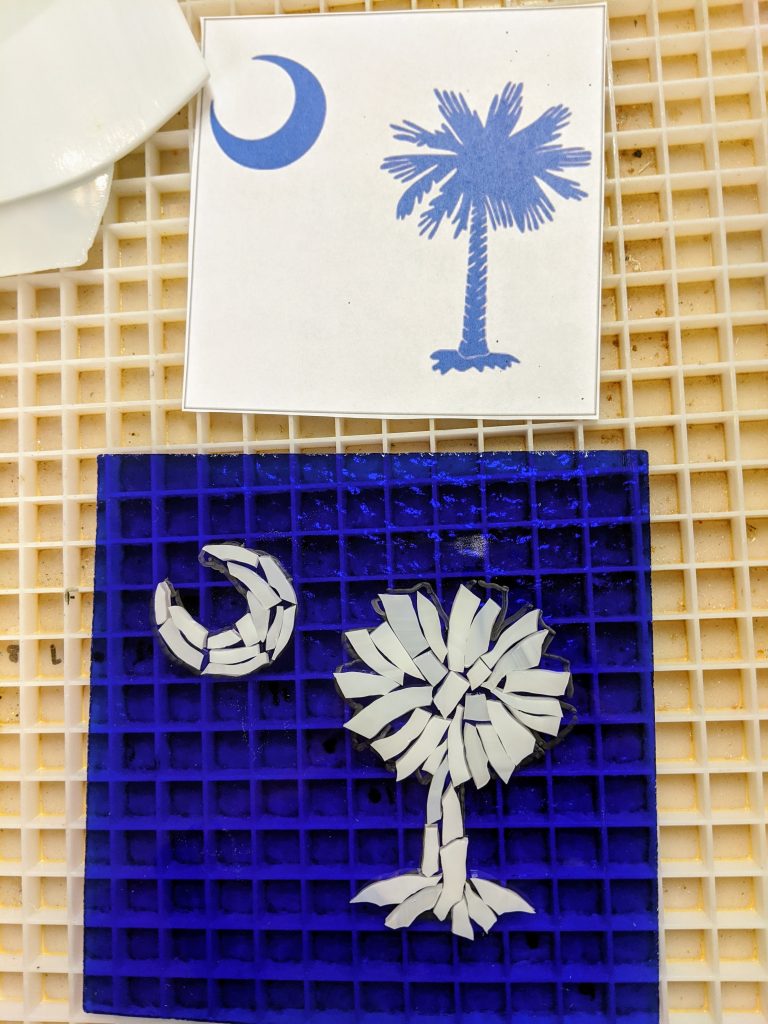
Somehow this didn’t look the way I had envisioned. In the past, I’ve used my glass saw to make the Palmetto and crescent for other mosaics. Looking around my work area, I wondered why I haven’t been using my saw for the past few years. I basically have been using it as a surface on which to store my measuring cups and mix my resin. So I decided to move all of that aside and clean up my old saw. At one point I was using it so often that I became pretty much an expert at repairing things when parts broke or wore out on the saw. I was a bit concerned that there was something broken because I haven’t used it in so long.
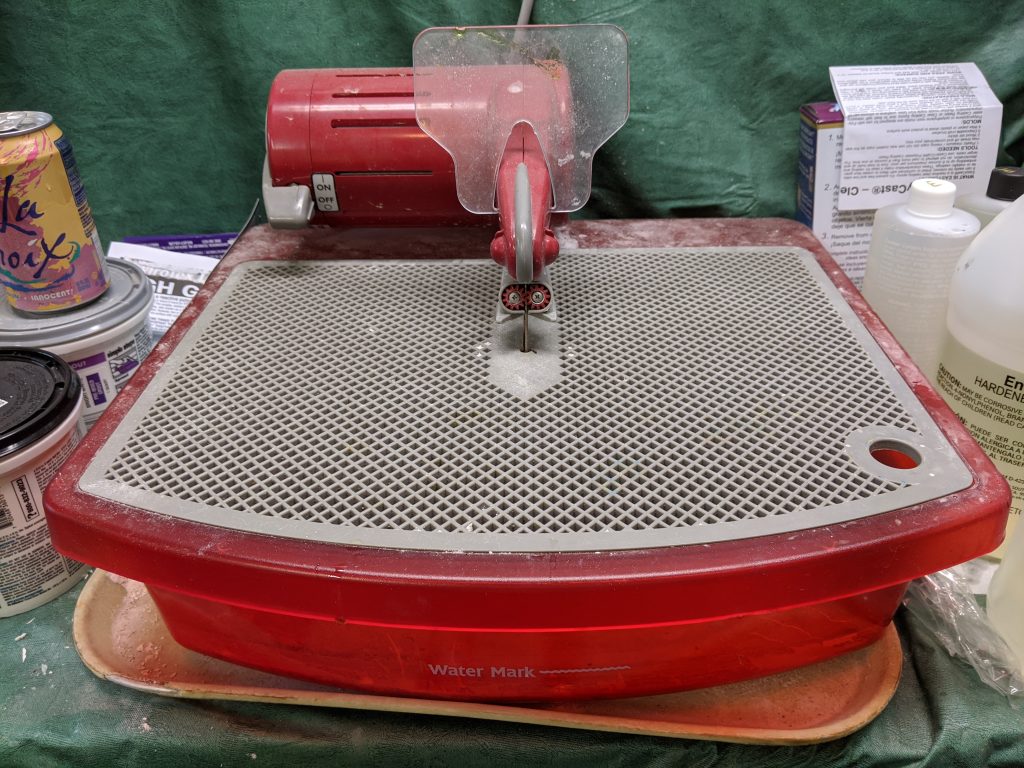
I cleaned it out and put some water in the basin and flipped the switch – hurrah! It worked! I then traced the pattern onto some scrap glass, cut it down a bit manually and added some mark stay over the lines I drew. Mark stay is basically a chapstick like substance that helps the lines stay in place while sawing (it is very wet and the marker lines wash away otherwise).
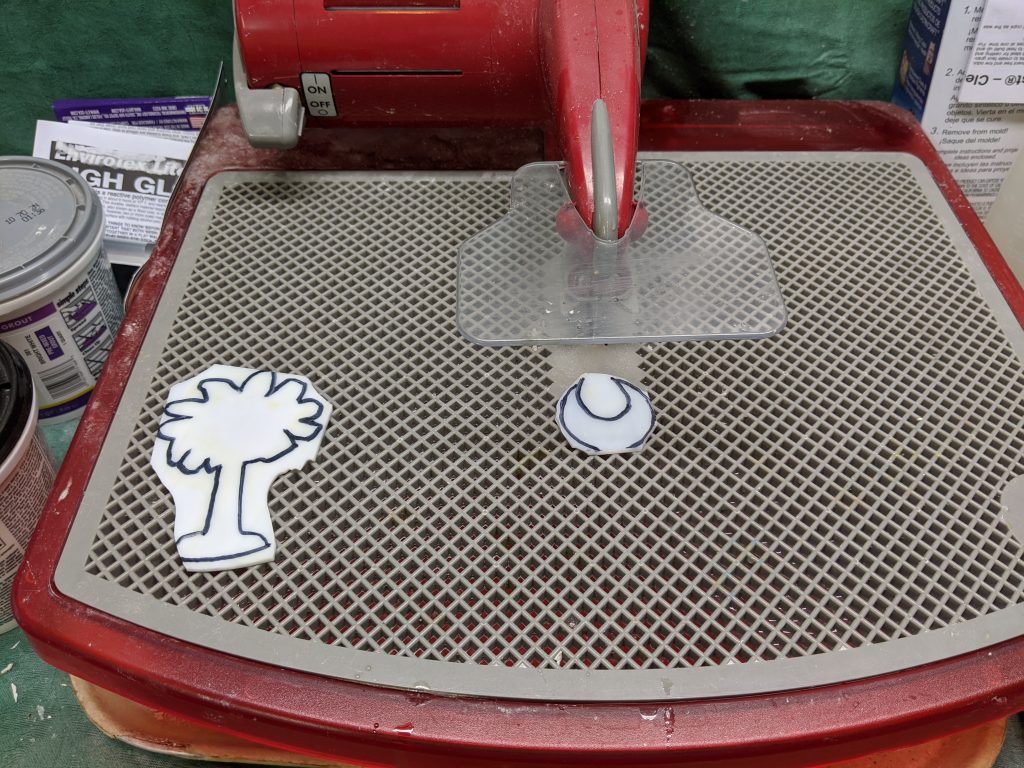
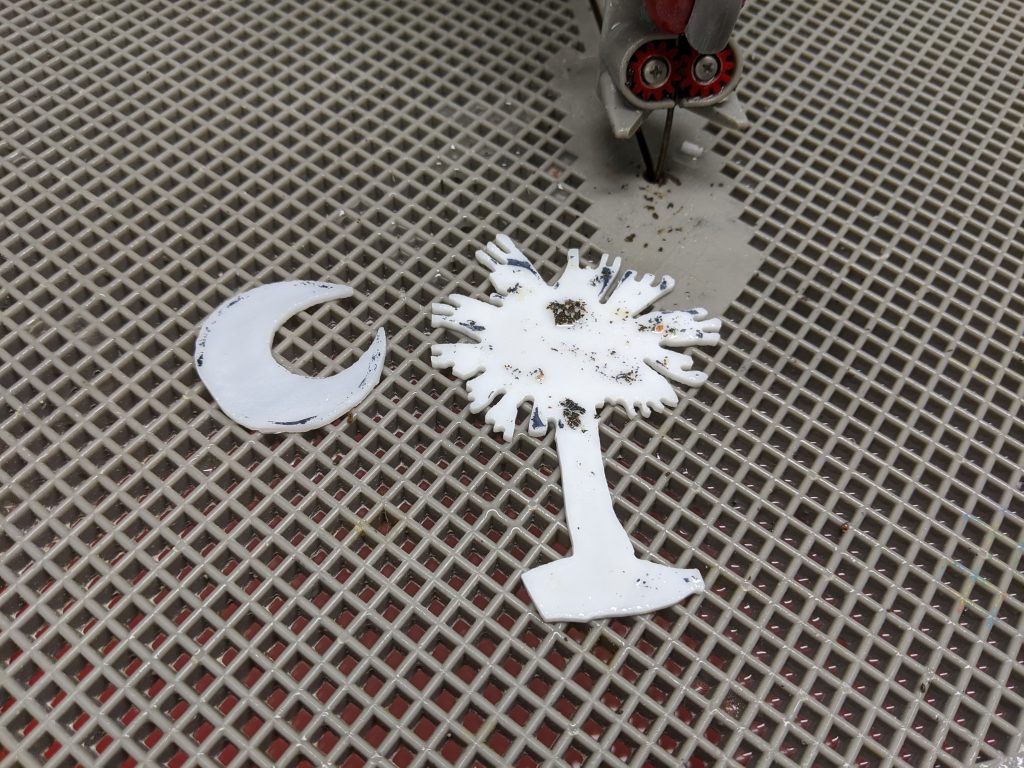
I cut out the basic outline and cleaned up the glass, then went for another pass to add some detail.
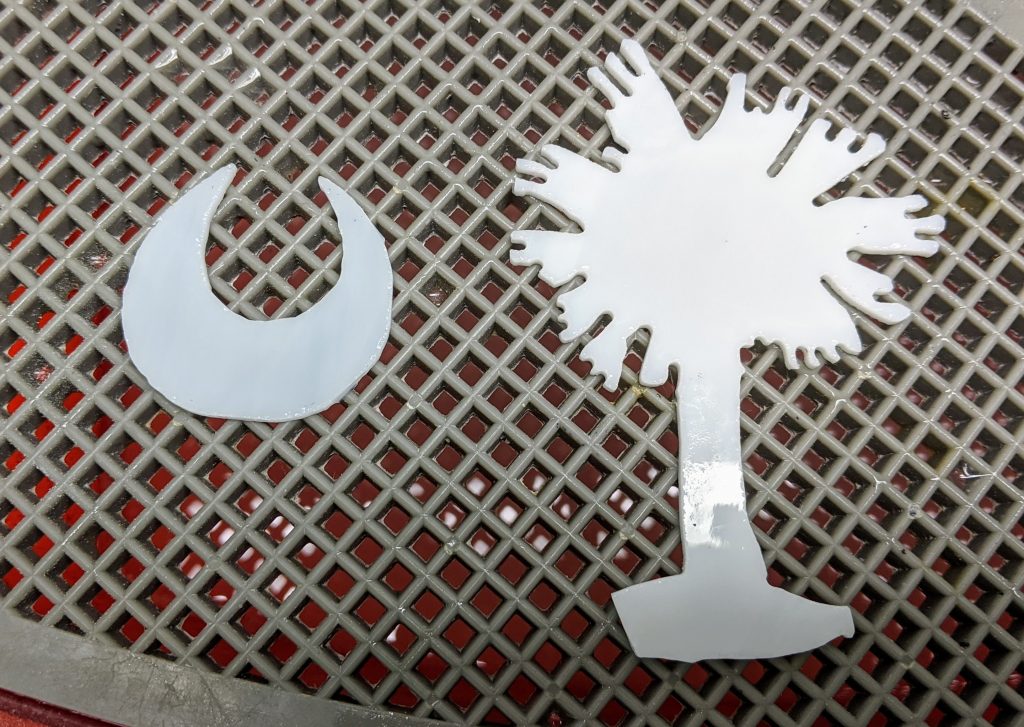
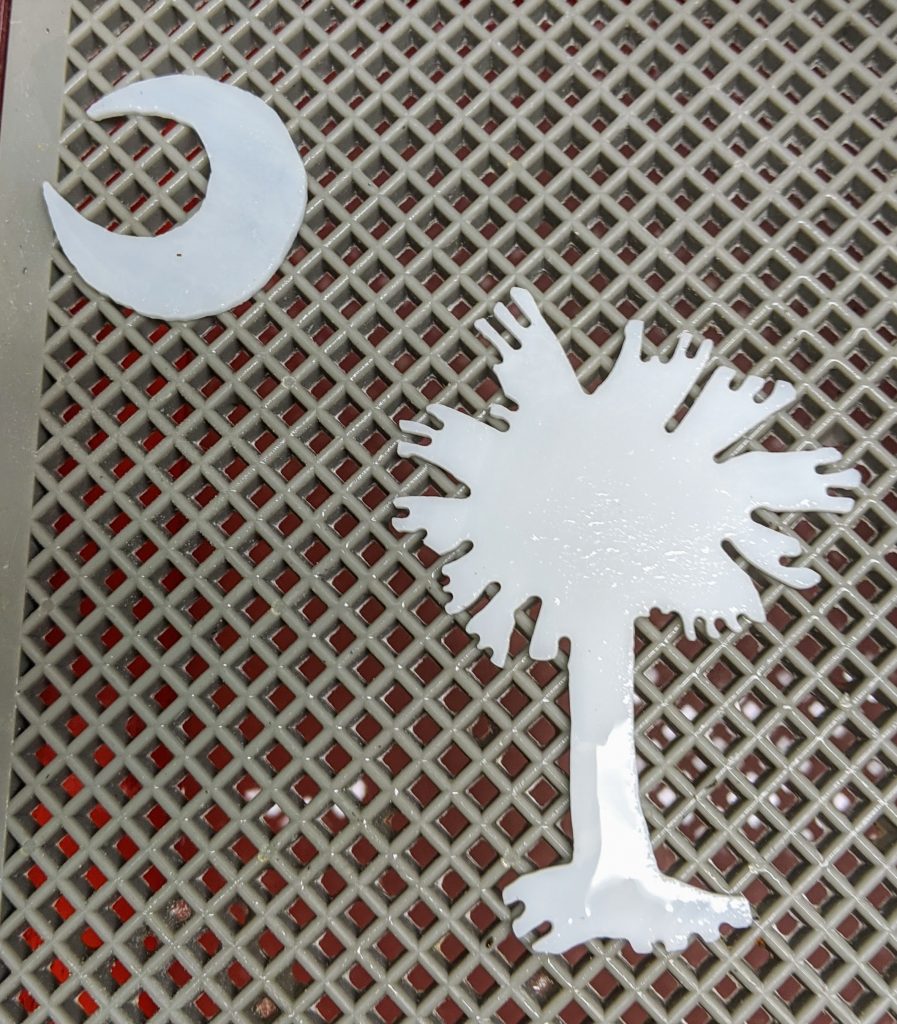
Then it was time to see how it looked on the blue background. I think I could make the crescent a bit skinnier.
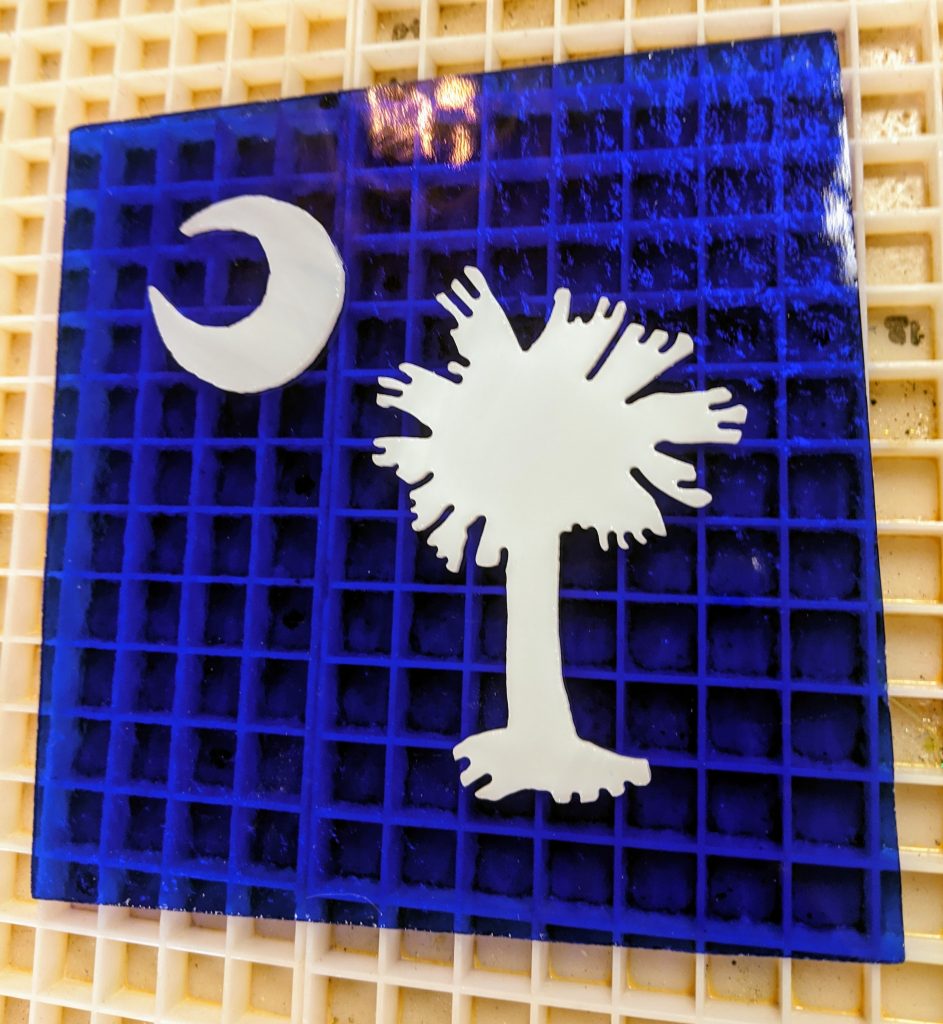
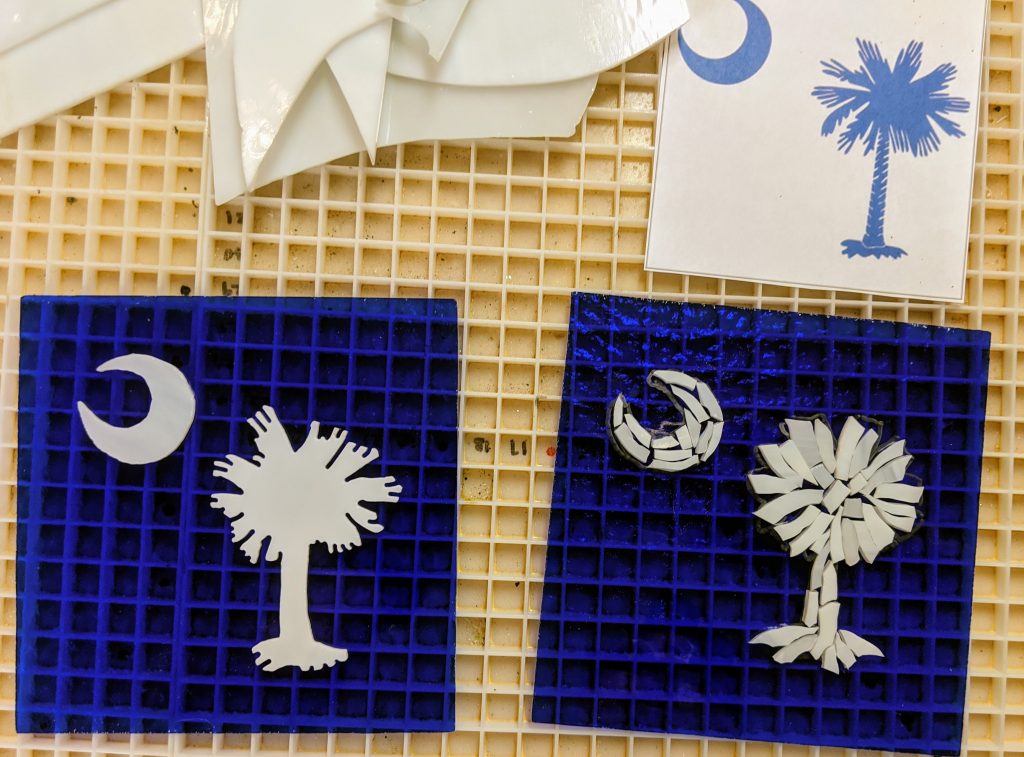
Which one do you like better? I still have to glue the pieces in place, then pour and embellish the resin coating. That will happen another day.
A note on the SC Flag – many who don’t know the history of the flag think that the crescent is a moon. It’s not. Here’s an excerpt from Wikipedia:
In 1775, Colonel William Moultrie was asked by the Revolutionary Council of Safety to design a flag for the South Carolina troops to use during the American Revolutionary War. Moultrie’s design had the blue of the militia’s uniforms and the crescent. It was first flown at Fort Johnson.[1] This flag was flown in the defense of a new fortress on Sullivan’s Island, when Moultrie faced off against a British fleet that had not lost a battle in a century.
However, there is much debate about the significance of the crescent. In his memoirs, Colonel William Moultrie tells us: “A little time after we were in possession of Fort Johnson, it was thought necessary to have a flag for the purpose of signals: (as there was no national or state flag at that time) I was desired by the council of safety to have one made, upon which, as the state troops were clothed in blue, and the fort was garrisoned by the first and second regiments, who wore a silver crescent on the front of their caps; I had a large blue flag made with a crescent in the dexter corner, to be in uniform with the troops …” In the 16-hour battle on June 28, 1776, the flag was shot down, but Sergeant William Jasper ran out into the open, raising it and rallying the troops until it could be mounted again”. This gesture was so heroic, saving Charleston, South Carolina, from conquest for four years, that the flag came to be the symbol of the Revolution, and liberty, in the state and the new nation.
Soon popularly known as either the Liberty Flag or Moultrie Flag, it became the standard of the South Carolinian militia, and was presented in Charleston, by Major General Nathanael Greene, when that city was liberated at the end of the war. Greene described it as having been the first American flag to fly over the South.
Today I tried adding windows and doors to a couple of the houses on these Rainbow Row pieces. I just wasn’t feeling the love for them. I’m not good with painting / drawing at all and they didn’t look the way I had hoped, so I removed them and decided to focus on the Palmetto trees today. Maybe I can add enough visual interest with plants. I glued the trees and greenery in place, but I haven’t glued the red glass flowers in the shrubs yet. Still thinking about that.
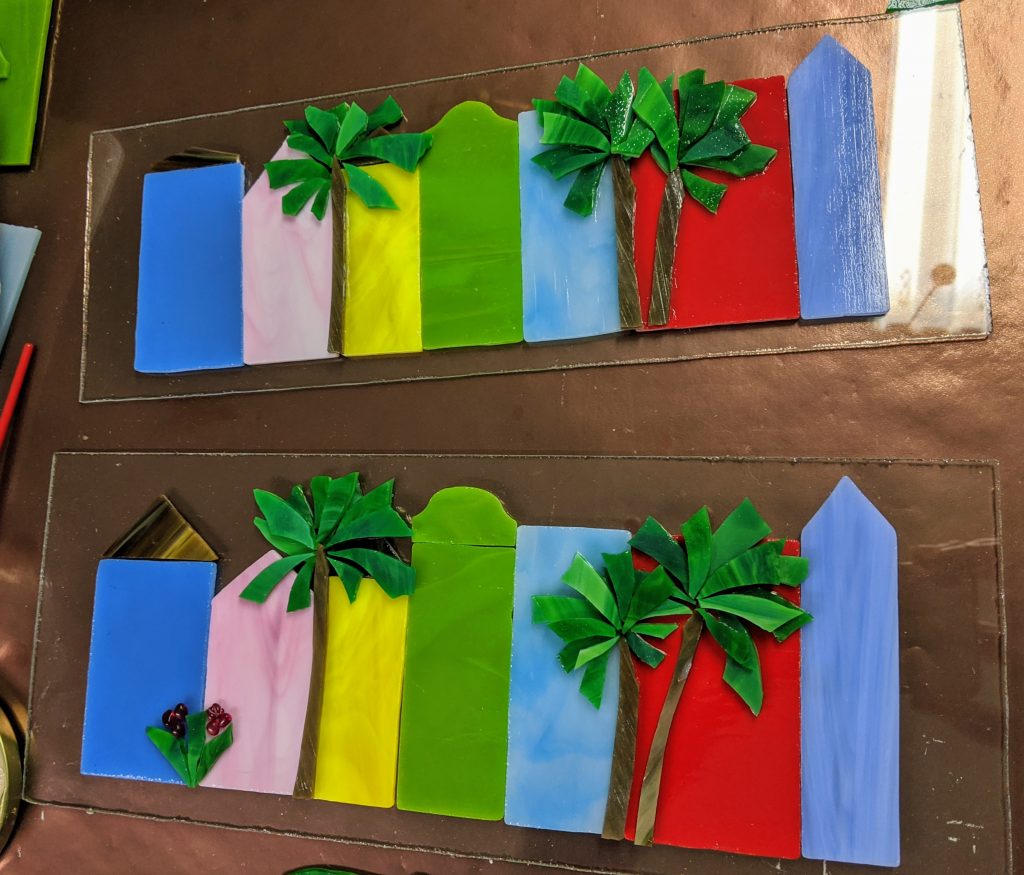
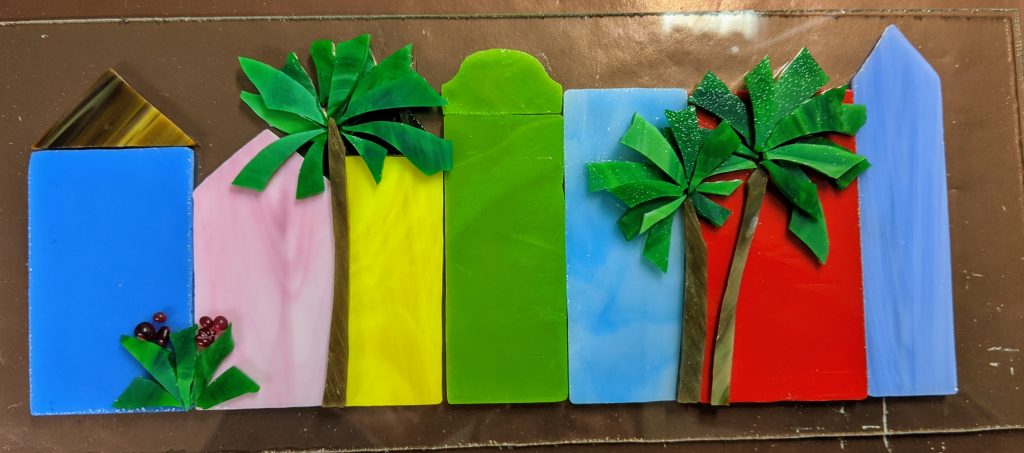
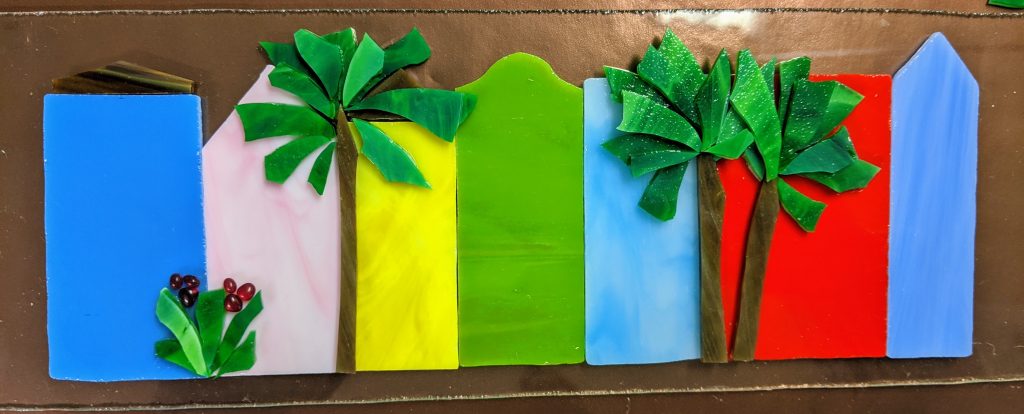
Maybe if I make them a bit smaller next time I will like the look a little better. I still feel like these need more decoration. I have considered making windows and doors out of glass, but they would really stick out. I decided to try that and see how it looks.
In the mean time, the little trees inspired me to try designing some smaller pieces (larger than ornaments, but about a third of the size of the above pieces) with the Palmetto and Crescent for the South Carolina flag. I often have people ask about pieces with the SC flag (I’ve made large window mosaics as well as stepping stones with it in the past).
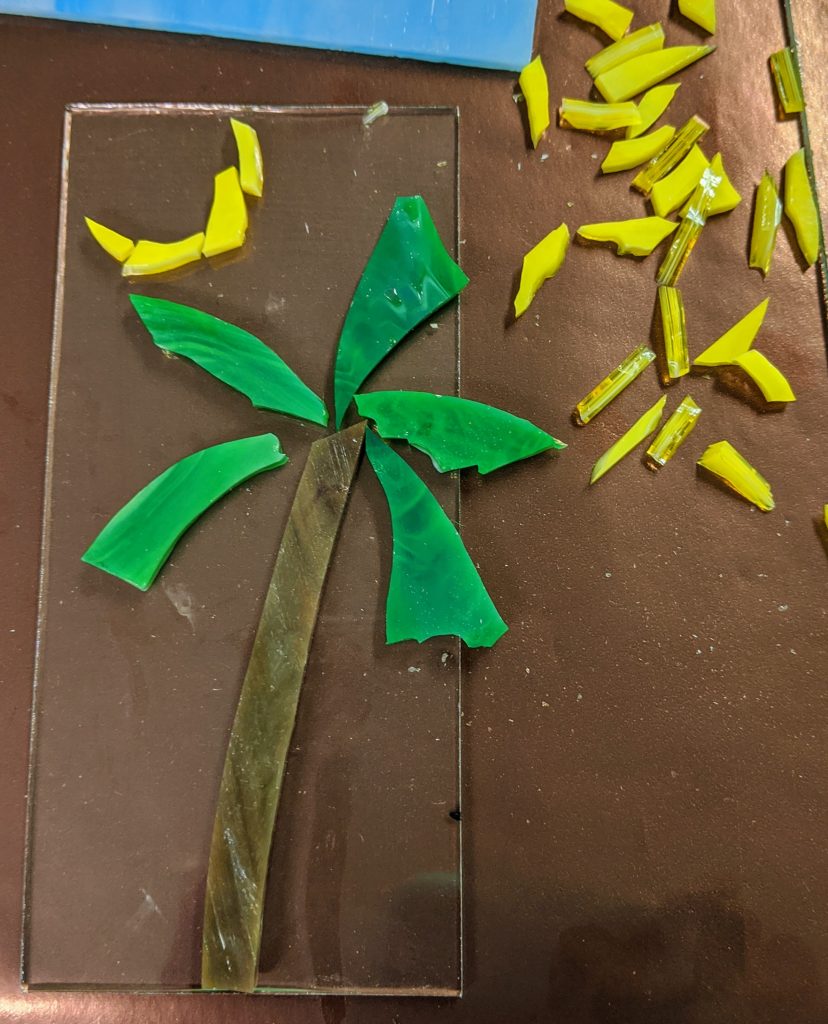
I’ll need backer glass that’s about twice this size. I’ll also likely use white and blue glass for the Palmetto and the Crescent, but this is just for brainstorming.